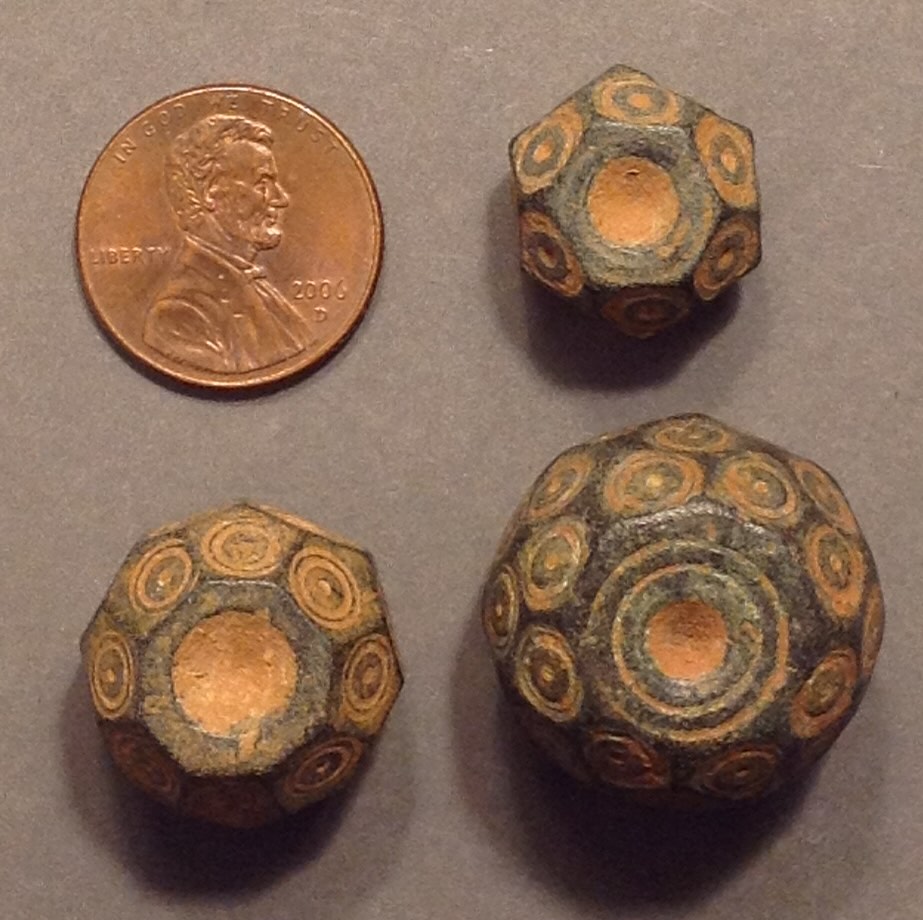 Islamic Polyhedral Weights
Islamic Polyhedral Weights
Small commercial weights with polyhedral shapes (a.k.a. "multi-faceted" weights) are commonly found in Syria, Lebanon, Jordan, Israel, and Egypt. The most common polyhedral weight denomination has mass about 14.7 grams and is called a "5-dirham" weight, which implies a dirham mass of c. 2.94 grams. The weights are almost spherical except for the flat sides.
To the right: Three weights of denominations 5, 10, and 20 dirhams next to a US cent. (The weights are discussed individually below.) The cent is 19 mm in diameter. Weights with this design are attributed to the Fatimids. They are imprecisely dated from c. 940 AD to c. 1190 AD.
The 5-dirham weight usually has 20 sides--two large hexagonal sides (shown face on) and 18 smaller sides in three rows of six sides (next image). This denomination is common.
What's new? 2025, Dec. 16: A remarkable very small truncated-cube half-dirham weight, #1368).
2025, Oct. 14: Pages on Islamic flat weights, problematic weights, and Byzantine weights.
2025, Oct. 6: A comment on balances.
2025, Sept. 1: A 2-dinar weight with weak lettering.
2025, August 22: 10-dirham truncated cube.
2025, July 27: A 2-dinar weight with, on each side, a line with two vertical strokes at each end.
2025, July 25: A note from Bendall about weights with incorrect masses.
2025, July 18: A 10-dinar octogonal weight. A 20-dirham barrel-shaped weight. Additional references.
[All images below are to scale. Click the images for enlargements of them.]
The "bird's eye" design. Next is the most common polyhedral type: a 5-dirham piece with two hexagons with three rows of sides between them and with sides decorated with what Holland calls "bird's eyes," that is, a depression (dot) surrounded by one or more concentric circular grooves.
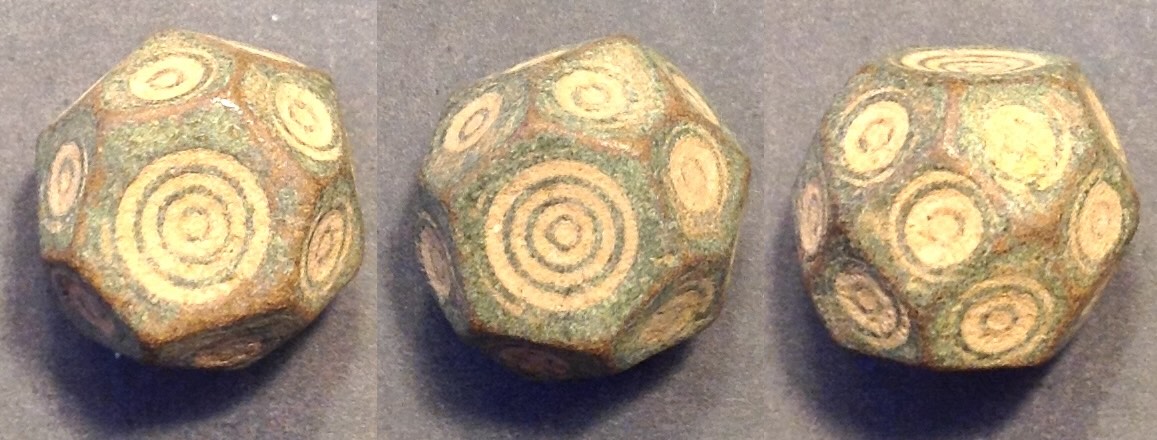 A 5-dirham weight with two hexagons and 18 smaller sides in three horizontal rows of six sides (or, you could think of it as having six diagonal rows of three sides).
A 5-dirham weight with two hexagons and 18 smaller sides in three horizontal rows of six sides (or, you could think of it as having six diagonal rows of three sides).
14.62 grams (2.924 grams/dirham). 12.8 mm between the hexagons. 15.2 mm maximum.
"Bird's eyes" on every side.
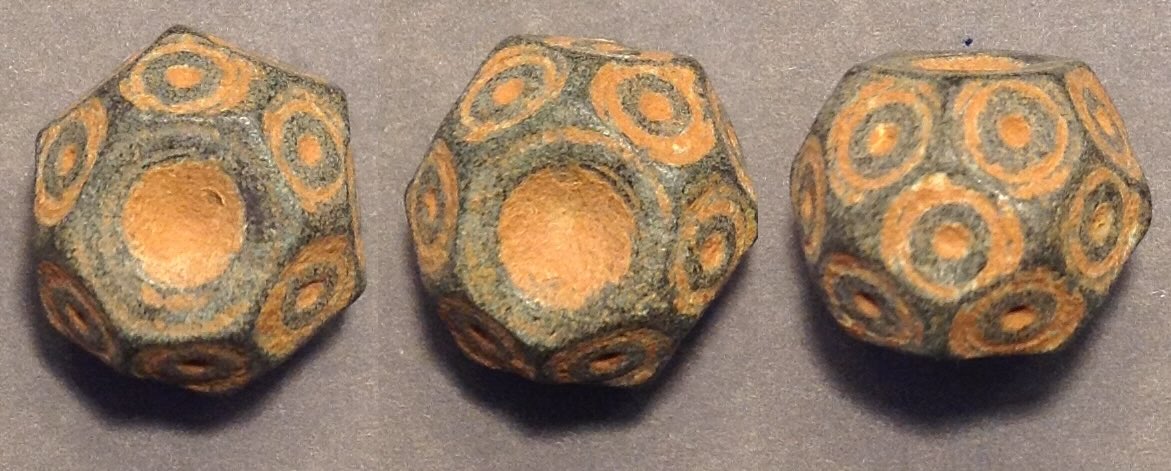 A 5-dirham weight of the same shape. (This is the upper right coin in the first photo.)
A 5-dirham weight of the same shape. (This is the upper right coin in the first photo.)
14.77 grams (2.954 grams/dirham). 12 mm between the hexagons. 17 mm maximum.
"Bird's eyes" on every side. On this example the central depressions on the hexagons are deep.
[Additional examples are on a second page.]
10-dirham weights. Polyhedral 10-dirham weights are also common, usually with two octagons instead of two hexagons, and tend to weigh about 29.4 grams. Larger denominations are much less common. There are 20-dirham polyhedral weights of c. 59 grams (below) and rare 50-dirham polyhedral weights. There are lighter polyhedral weights including scarce "2-dirham" polyhedral weights of c. 5.9 grams (below) and rare "1-dirham" polyhedral weights. Weights of 2 dirhams or less are very common--much more common than these--but rarely polyhedral. Usually they are small square or rectangular pieces of metal shaped like bricks (below).
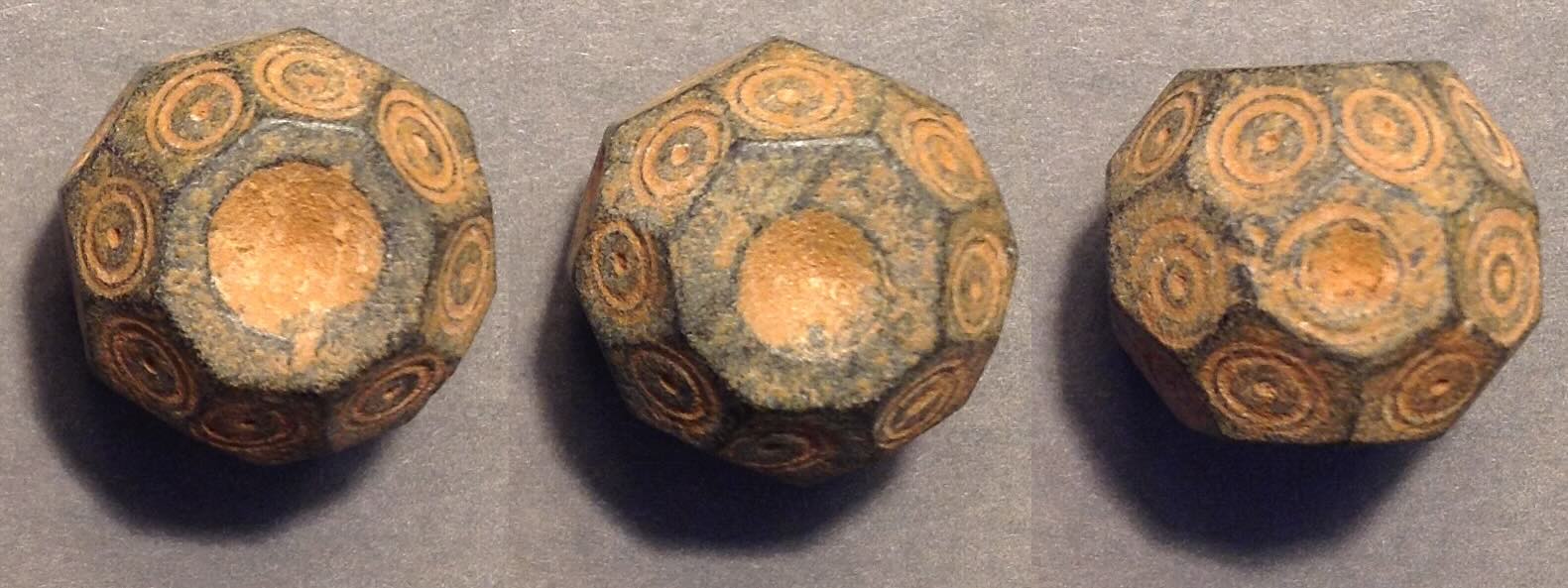 A 10-dirham weight with two octagons and 18 smaller sides in six diagonal rows of three sides each. (This is the lower left weight in the top photo.)
A 10-dirham weight with two octagons and 18 smaller sides in six diagonal rows of three sides each. (This is the lower left weight in the top photo.)
29.47 grams. 17 mm between the octagons. 19 mm maximum. (2.947 grams/dirham)
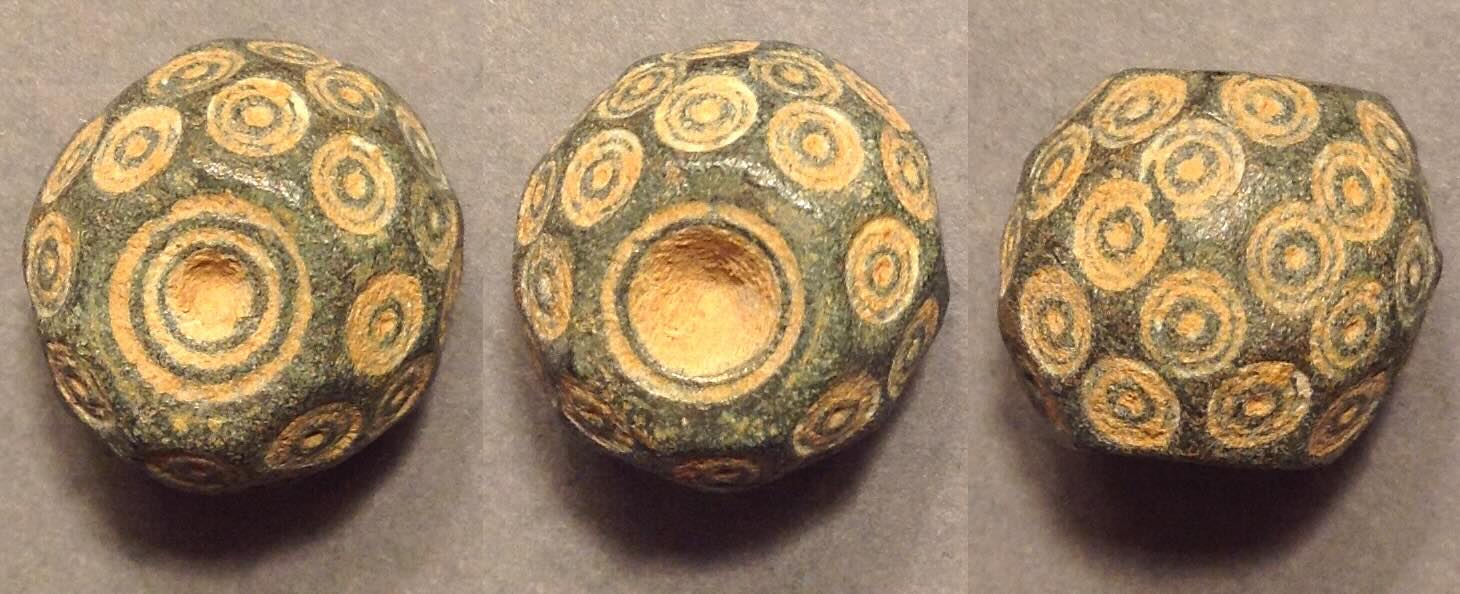 Another 10-dirham weight, but with more rows of bird's eyes.
Another 10-dirham weight, but with more rows of bird's eyes.
Two octagons and 40 smaller sides in eight diagonal rows of five sides each (photo on the right) (or, five rows of eight sides each).
29.25 grams. 19-16 mm. (2.925 grams/dirham)
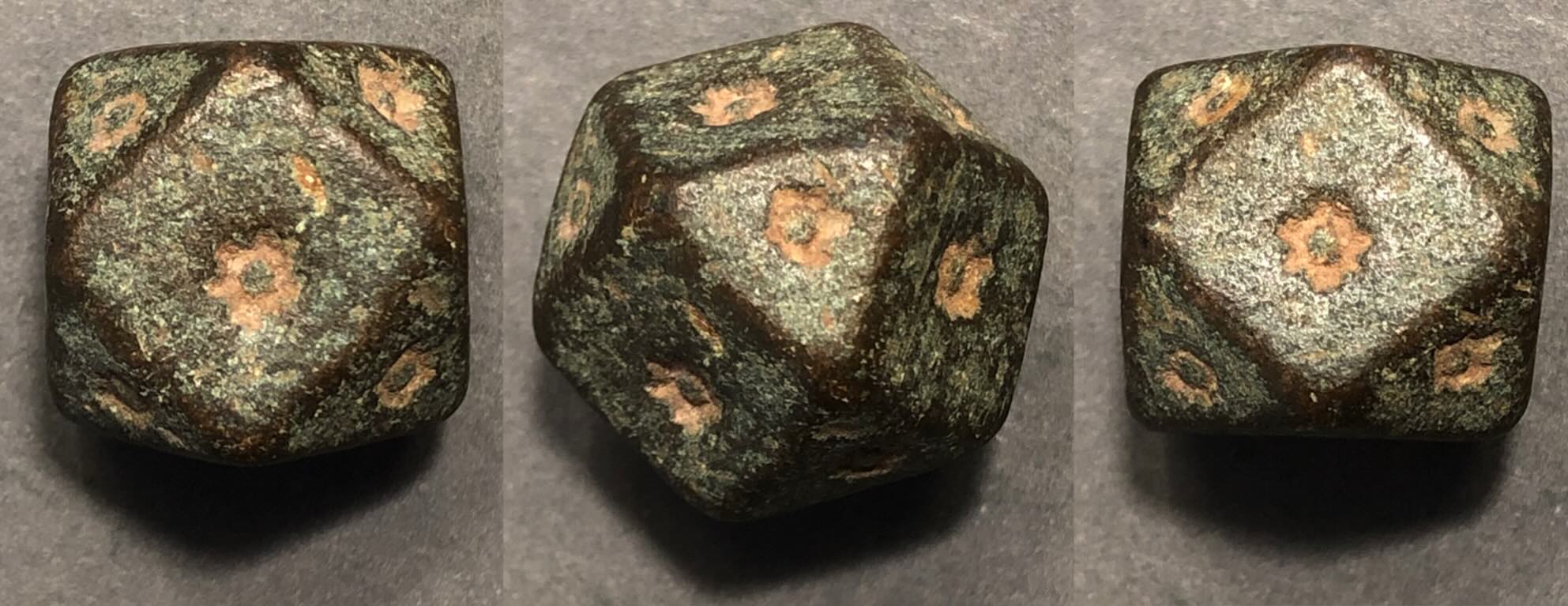 10-dirham truncated cube.
10-dirham truncated cube.
29.16 grams (2.92 grams/dirham)
17.1 mm by 15.0 mm cube. 18.3 mm diagonal.
A cube, truncated by lopping off all eight corners to form equilateral triangles and leaving a square face.
Small star-like punch mark on each face.
Smaller weights. Smaller weights of 2 dirhams or less are very common as brick-shaped (a.k.a. "flat"), but rare as polyhedrons.
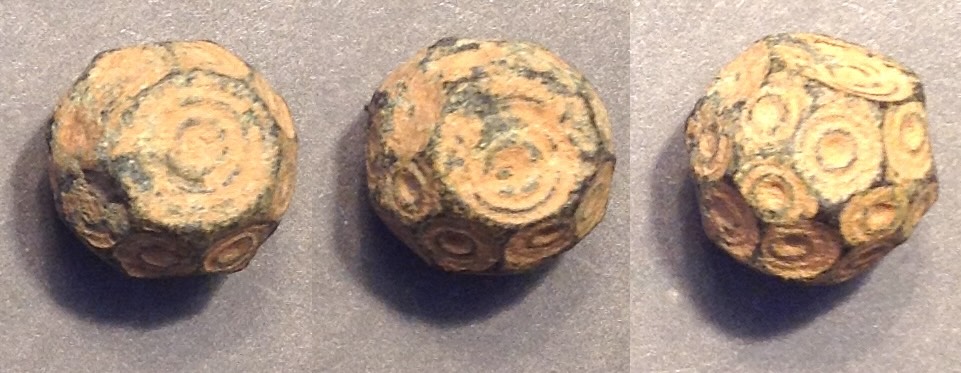 A rare 2-dirham polygonal weight with 26 sides--two octagons and three rows of eight 5- or 4-sided sides with bird's eyes.
A rare 2-dirham polygonal weight with 26 sides--two octagons and three rows of eight 5- or 4-sided sides with bird's eyes.
11.8-9.5 mm. 5.86 grams. (2.93 grams/dirham)
Remarkably small.
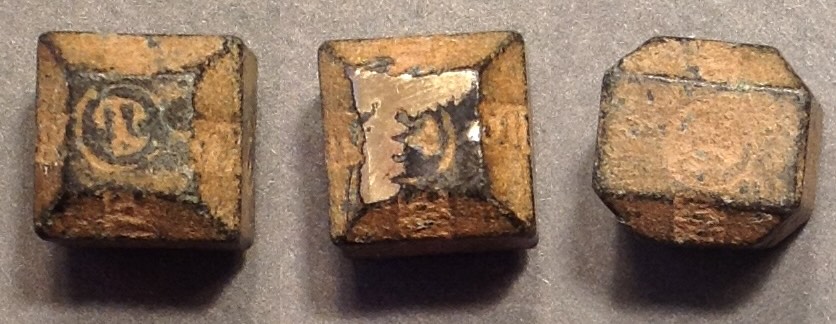 #524181
#524181
A rare 2-dirham polygonal weight with 14 sides. It is a truncated cube.
9.2 mm by 9.2 mm. 5.85 grams. (2.925 grams/dirham)
This example was damaged in the mail even though it was well-packed in a stiff cardboard envelope and in a bubble-wrap padded envelope inside. Something very heavy must have been set on it and scraped along it. You can see the scrape in the second image.
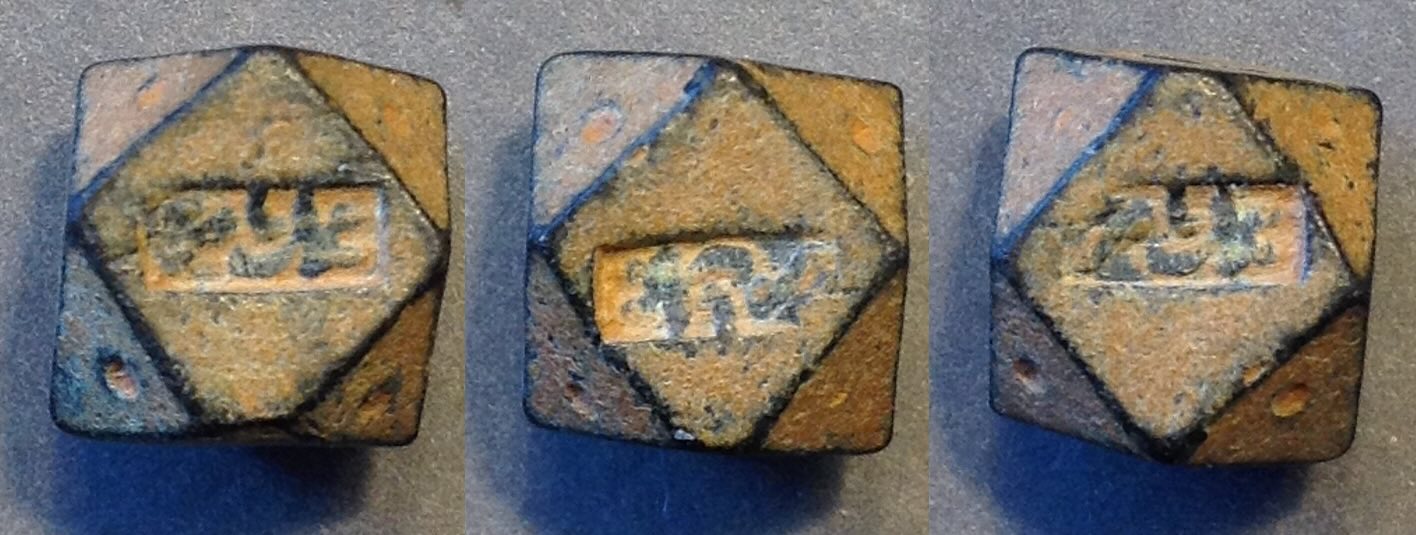 #1099
#1099
A rare 2-dirham polygonal weight, also with 14 sides, but shaped differently as a cube.
5.90 grams. (2.95 grams/dirham)
9.4 mm by 9.3 by 9.1 mm cube with the 8 corners cut off to form 8 equilateral triangles as sides along with 6 squares.
Each triangle has a dot (a punch mark) and each square has a rectangular illegible impression.
A tiny half-dirham weight of this shape is below.
"Brick shaped": Weights with low denominations (2, 1, and fractional dirhams) are usually brick-shaped--flat squares or rectangles.
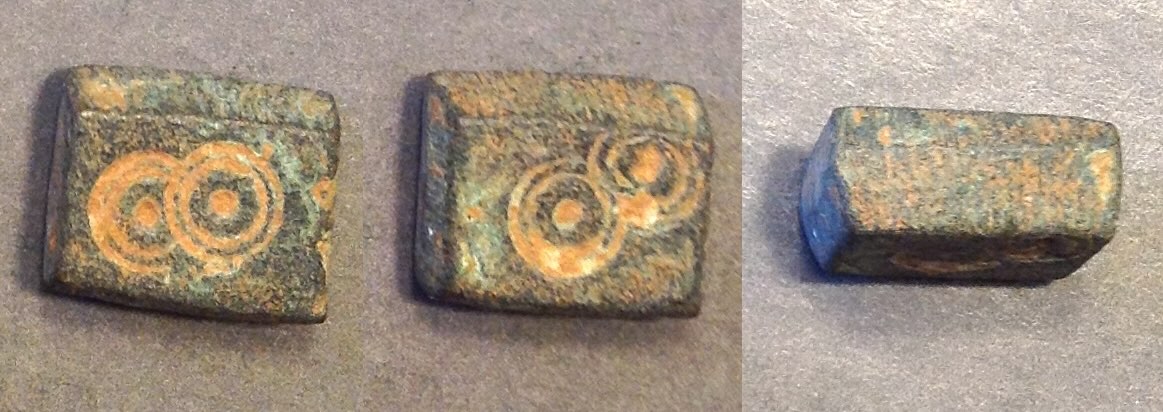
A 2-dirham weight. "Brick shaped."
5.73 grams (2.865 grams/dirham). 12.7 by 10.3 mm and 5.8 mm thick.
I suppose two bird's eyes served to mark this is a two-dirham weight, just as one bird's eye marks the second-next weight, a 1-dirham weight, however the next weight has the same mass but four bird's eyes.
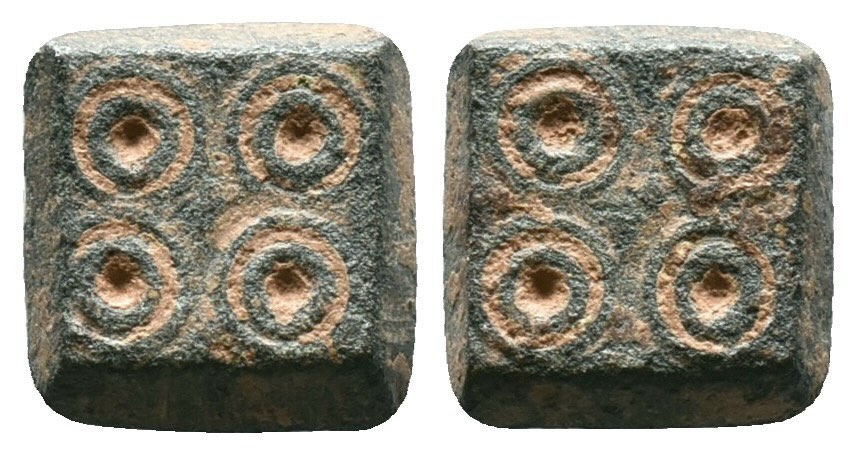 A 2-dirham weight. "Brick shaped."
A 2-dirham weight. "Brick shaped."
5.79 grams (2.89 grams/dirham). 12.1 by 11.7 mm and 5.5 mm thick.
I can't explain why the number of bird's eyes is four. It seems the number of bird's eyes is often the same as the number of dirhams, but not always.
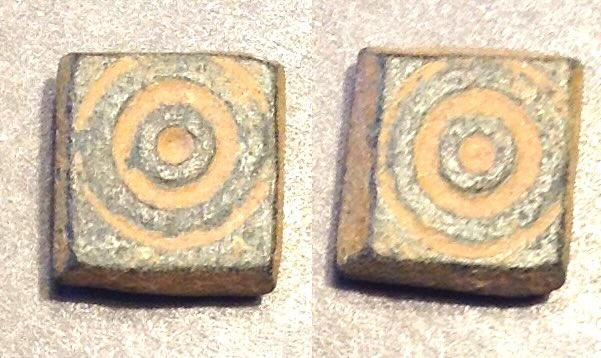 A 1-dirham weight.
A 1-dirham weight.
2.88 grams. 11.2 by 10.7 by 3.2 mm.
One bird's eye for one dirham.
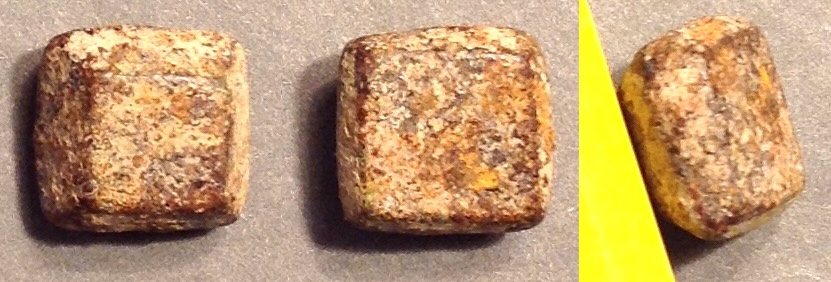 A 1-dirham weight.
A 1-dirham weight.
2.99 grams. 9.8 by 9.6 by 5.2 mm.
(The yellow is part of a pencil used to prop it up.)
No design. Nothing indicates that it is 1-dirham.
There are many lighter brick-shaped, flat, weights. The Islamic system of fractional denominations had 6 dots (punch marks) in a whole unit, so 3 dots denote 1/2 (3 out of 6) and 2 dots denote 1/3 (= 2/6). This is like the Greek system with six obols in a drachm. Greek silver hemidrachms (3/6) and diobols (2/6) and obols (1/6) (and even hemiobols) are common. Islamic fractions of 3/6 and 2/6 are common, but I have rarely seen fractions at the 1/6 weight or with one dot which would correspond to obols (although Holland (1984) published over 60 [18 with legends photographed] and another 25 at half that weight [c. 0. 24 grams, 4 photographed]). Are they rare on the market because they are too small to attract sellers and collectors?
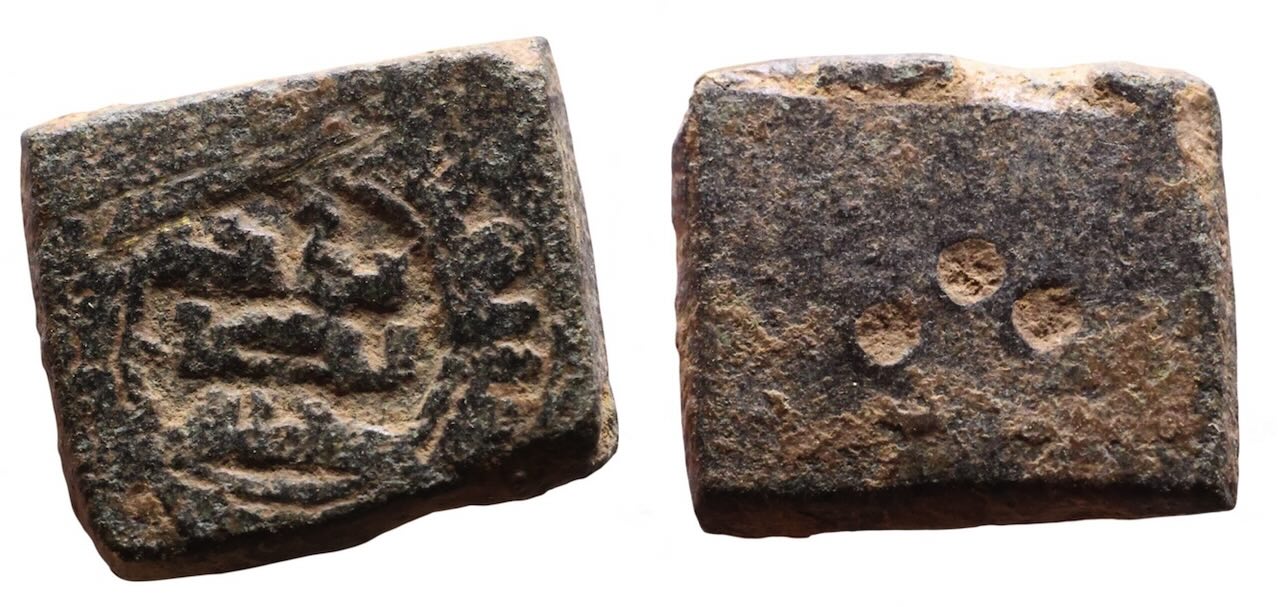 #1158
#1158
1.46 grams. A 1/2 dirham weight. (2.92 grams/dirham)
The rectangular shape indicates it is on the dirham standard and the three dots indicate 3/6 = 1/2.
9.3 by 8.1 by 2.4 mm.
The obverse legend awaits translation from some helpful reader.
What were weights for? When the silver dirham coin denomination was first issued c. 90 AH (c. 708 AD) it was good silver and weighed c. 2.94 grams (possibly 2.97 grams). This standard was maintained for coins for many decades. However, by the time the Fatimid dynasty took Egypt and the Levant in the early 10th century, silver and gold coins were no longer produced with a consistent mass. Fatimid silver coins are mostly half- or quarter- dirhams (coin) which are scarce compared to earlier Islamic silver coins. According to Holland, every transaction involving silver must have had the silver weighed, apparently using the old dirham standard. Holland (WWOCM) notes the mystery that while the weights are very numerous, balances and even parts of balances are extremely rare.
A balance illustrated on a Roman coin.
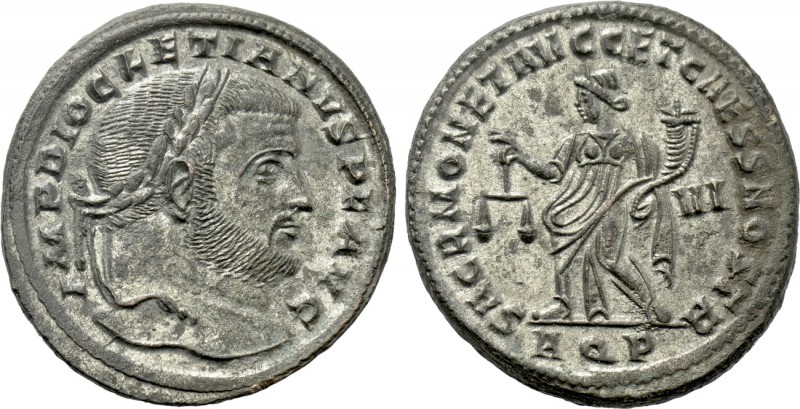 A follis (nummus, 27 mm. 10.04 grams) of Roman emperor Diocletian (284-305 AD) with the reverse illustrating the personified Moneta holding a balance. She holds it between the thumb and index figure with the other fingers held up to show they are not tipping the balance. The coin's reverse legend is
A follis (nummus, 27 mm. 10.04 grams) of Roman emperor Diocletian (284-305 AD) with the reverse illustrating the personified Moneta holding a balance. She holds it between the thumb and index figure with the other fingers held up to show they are not tipping the balance. The coin's reverse legend is
SACR MONET AVGG ET CAES NOSTR
"Sacred money/coin of our Augusti and Caesars"
It refers to the good weight and value of the money produced by the mint in accordance with the currency edicts of 301.
Miles (1951) discusses earlier Arabic glass stamps (from Egypt) and weights with legends that explicitly mention phamaceutical products. He thinks these early weights were used to weigh drugs and expensive botantical products like dyes. Perhaps later polygonal weights served that purpose too.
Warren Schultz wrote to me, "The assumption has long been that they were used to weigh light but precious substances. Such things as gems, bullion, pharmaceuticals, etc. I would add coins to that list as well." Perhaps we could add spices and silk to that list.
Dates. Warren Schultz wrote to me, "One aspect that helps support the Fatimid-era dating of these objects is the style of Arabic script used. Most of the inscriptions are written in the Kufic style of script, which is an early form and often described as 'boxy'. It is also the style used on Fatimid coins." The "bird's eye" design is Fatimid and numismatists who are very familiar with Islamic coins who saw one would immediately think "Fatimid," according to Steve Album. The separated central circle with a dot in its center was introduced by al-'Azīz Nizār (975-996), the fifth Fatimid caliph, and used on all his gold and silver coins (with just a few minor exceptions), but not used again (with rare exceptions).
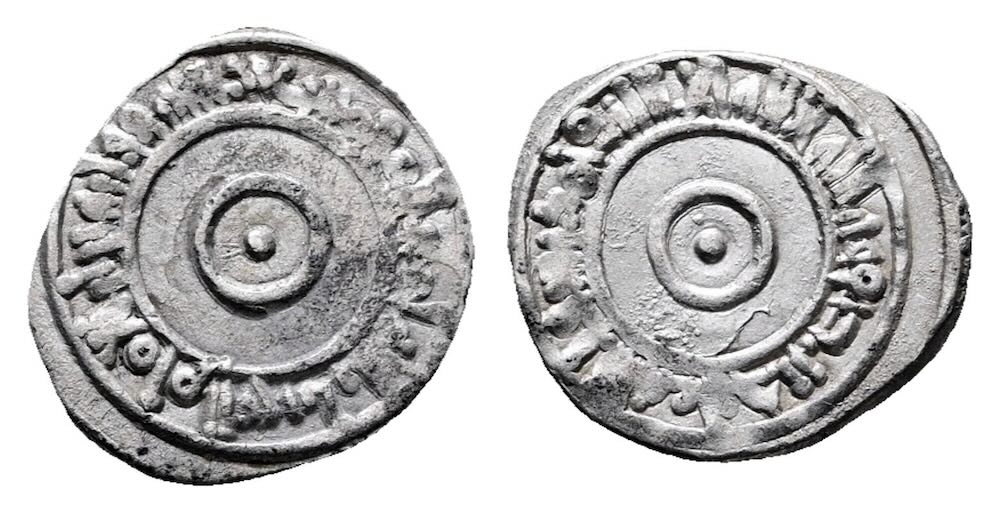 Fatimid ruler al-'Azīz Nizār (a.k.a. al-Aziz Billah) 975-996. AH 365-386.
Fatimid ruler al-'Azīz Nizār (a.k.a. al-Aziz Billah) 975-996. AH 365-386.
14.3 mm. 0.63 grams. Small and thin.
1/4 dirham (0.63 times 4 is only 2.52 grams, not 2.94 grams, but this one is clipped around the rim, as most other examples are.)
His full title is "abū manṣūr al-‘azīz billah," but his kunya Abū Manṣūr is almost never engraved on his coins.
Album 706.
There is much we don't know about Islamic weights. Very few can be dated with a narrow date range.
Weights with legends. The great majority of polyhedral weights do not have any Arabic legend.
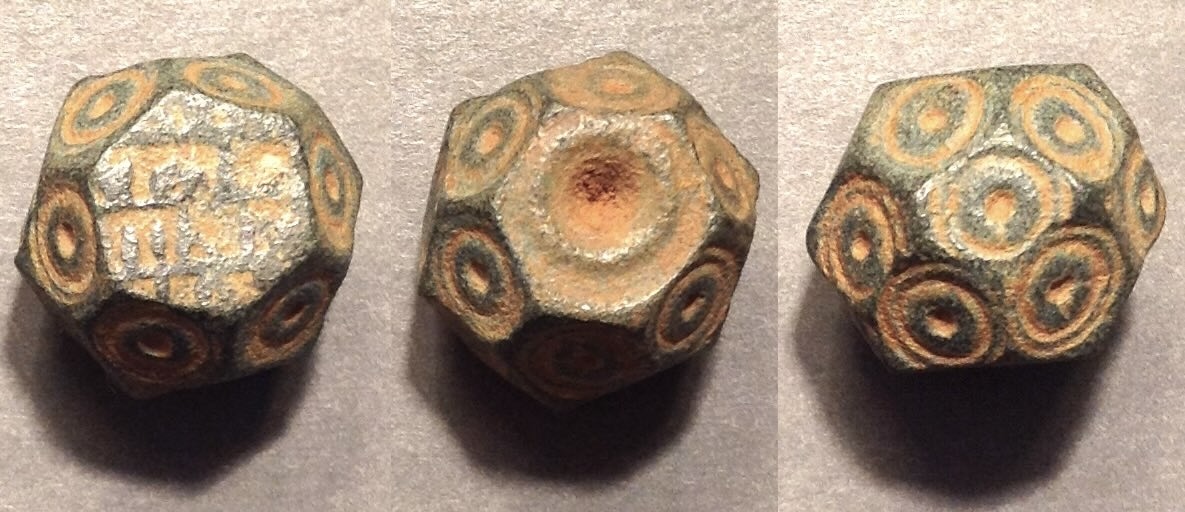 A 5-dirham weight.
A 5-dirham weight.
16-13 mm. 14.75 grams (2.95 grams/dirham).
On this example, one of the hexagonal sides has an Arabic legend. Only a small fraction have any legend. Holland (1986) notes that when they do at Caesarea Martima (in modern Israel) it is usually the short word 'imrān, but we don't know what that word means (no examples of that legend are on this site). Sometimes ruler's names are on such weights from c. 940 AD to Saladin c. 1190 AD. I approached experts in Arabic paleography, but they couldn't make this one out. (Some "brick" weights with legends that can be read are next.)
Brick weights (flat weights). Most 2-dirham and 1-dirham "brick" weights do not have legends, but some do. Holland (1986, p. 176) says that legends are (like coin devices) punched with an engraved die and therefore in relief.
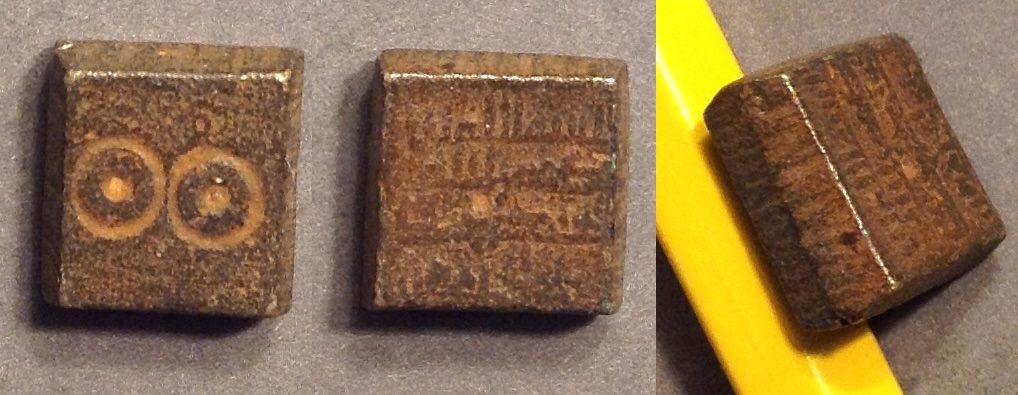 2-dirham weight. Brick shaped.
2-dirham weight. Brick shaped.
5.70 grams (2.85 grams/dirham). 12.1 by 11.7 mm and 5.3 mm thick.
(The yellow is part of a pencil used to prop it up.)
Two bird's eyes for two dirhams.
Four lines of legend:
In the name of God [la llah illa Allah]
Muhammad is the prophet of God [Mohammed rasul Allah]
Al-Qadir Billah (Abbasid caliph in Baghdad from 991 to 1031)
Commander of the believers [Amir al-Mu’minin]
The first two lines are the usual two parts of the Kalima and the next two give the name and title of the caliph.
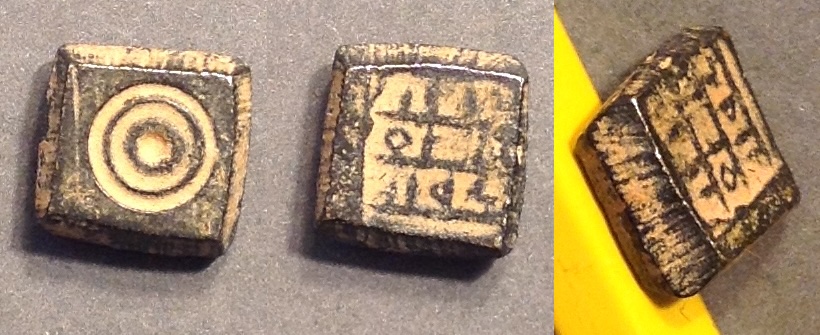 1-dirham weight.
1-dirham weight.
2.88 grams. 9.7 by 9.7 mm and 4.1 mm thick.
One bird's eye and a three-line legend.
First line uncertain followed by
Sayf
al-Dawla ("Sword of the state" who ruled at Mosul 942-967.)
There is a different page devoted to Islamic flat weights.
Larger weights. Larger weights have more sides. They are scarce.
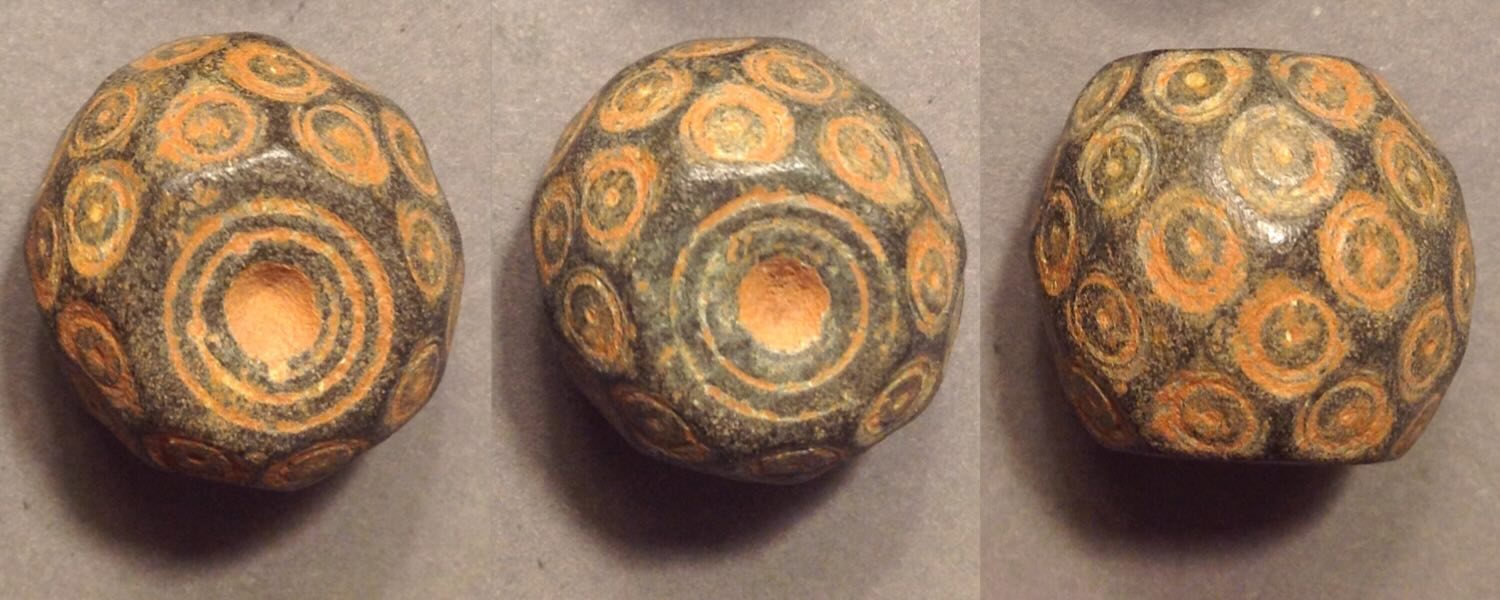 20-dirham weight with 42 sides. (This is the lower right weight in the top photo.)
20-dirham weight with 42 sides. (This is the lower right weight in the top photo.)
58.2 grams. 23-20 mm. (2.91 grams/dirham)
Two octagons and 40 smaller sides in eight diagonal rows of five each (third photo). (Or, five horizontal rows of eight each.)
#24217
20-dirham weight with 14 sides.
59.8 grams. (2.99 grams/dirham). 20.3 mm between opposite squares. 23 mm between opposite triangles. 27 mm maximum.
Six squares and eight triangles. A truncated cube, with each of the eight corners cut off to make an equilateral triangle.
Small circular depressions in each side, each with three dots.
This one lacks bird's eyes and is a little heavier. Maybe it is not Fatimid from the same time period as the others. However, the 10-dirham weight of this shape (above) is only 2.92 grams/dirham, so that weight difference may be meaningless.
There are also rarer 50-dirham polyhedral weights.
Barrel shape. Barrel weights have been found in Roman contexts, including at Pompeii. Byzantines also used barrel weights (example). However, Islamic barrel weights are common and barrel weights are likely to be Islamic if the mass is right, that is, some multiple of a dirham.
 #524219
#524219
10-dirham weight of barrel shape.
29.56 grams (2.96 grams/dirham).
18.5 mm wide by 14.1 mm high.
The large circles on the ends do not look like the usual bird's eyes.
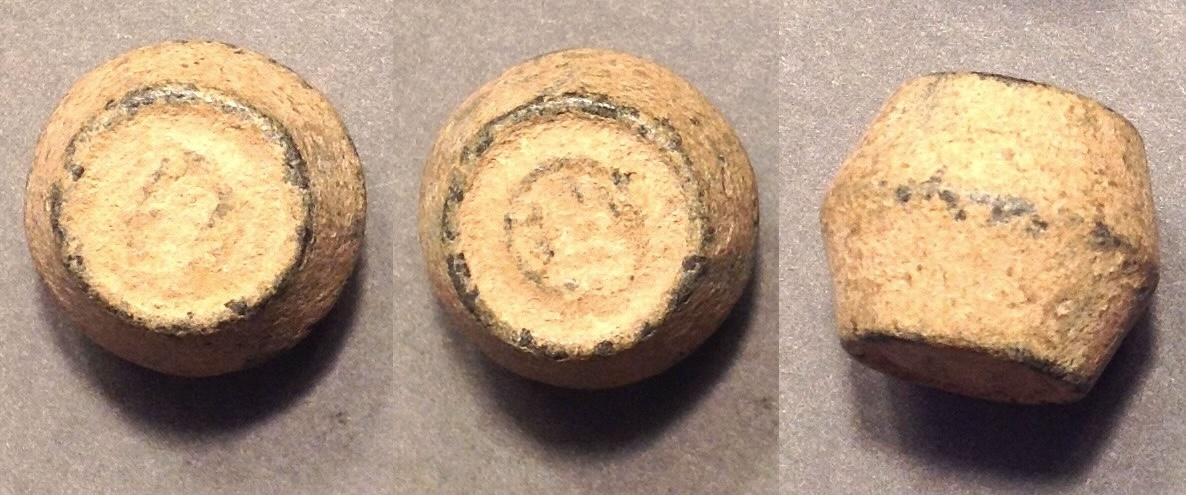 #524154
#524154
5-dirham weight of barrel shape.
14.90 grams (2.98 grams/dirham).
15.2 high by 12.2 mm wide.
The ends are very nearly circular, making the cross-section also nearly circular.
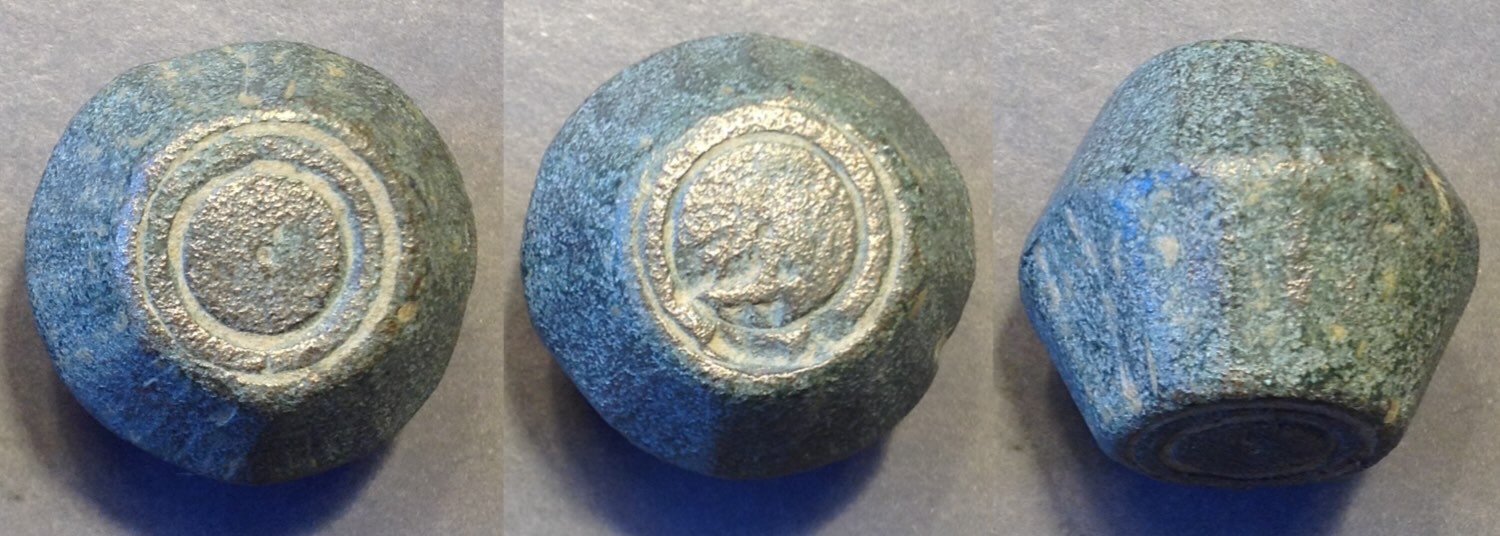 #877
#877
Barrel weight.
A 20-dirham weight.
59.55 grams. (2.978 grams/dirham).
20.7 mm wide by 24.7 mm tall.
This shape has been described as "truncated double cones with a distinct linear edge around the waist where the bases of the two cones meet." [Balog, p. 235].
Is it a coincidence that these three weights with this shape have a slightly higher mass-per-dirham than the other shapes? Could they be from a different time period, or place, where the weight standard was slightly different?
Other Shapes. Some weights are similar to the polyhedra above but without the "bird's eye" pattern in the polygons and the with the sides more rounded. They have been called "spheroids." Holland calls this next spheroidal design a "peeled orange" [WWOCM, Chapter 8, page 150]
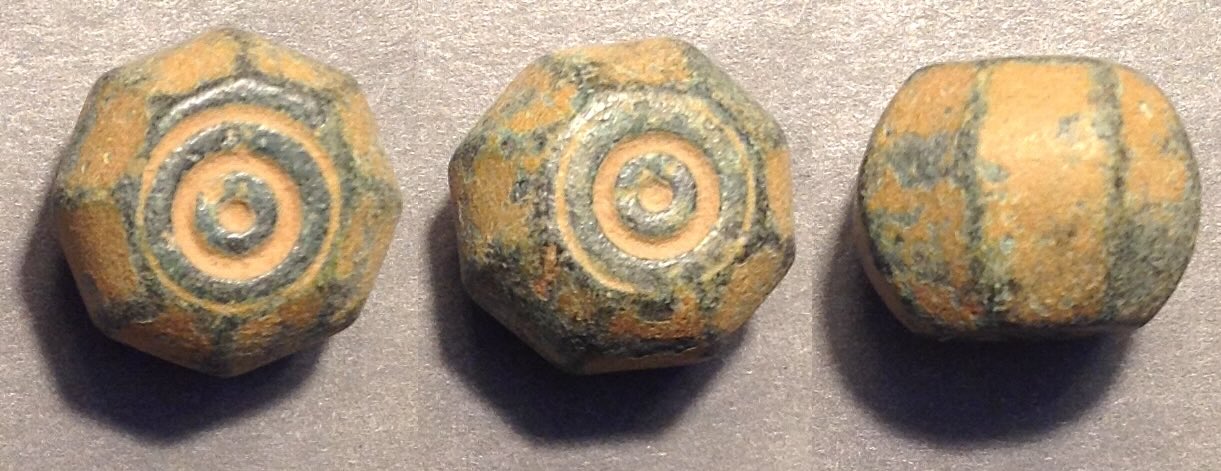 #1525
#1525
5-dirham weight of "peeled orange" shape with two octagons and 24 smaller rounded sides in eight vertical rows of three nearly-square sides each. Each side is rounded making this weight almost a truncated sphere.
"Bird's eye" pattern only in the octagons.
14.40 grams (2.88 grams/dirham). 12 mm between the octagons. 15 mm maximum.
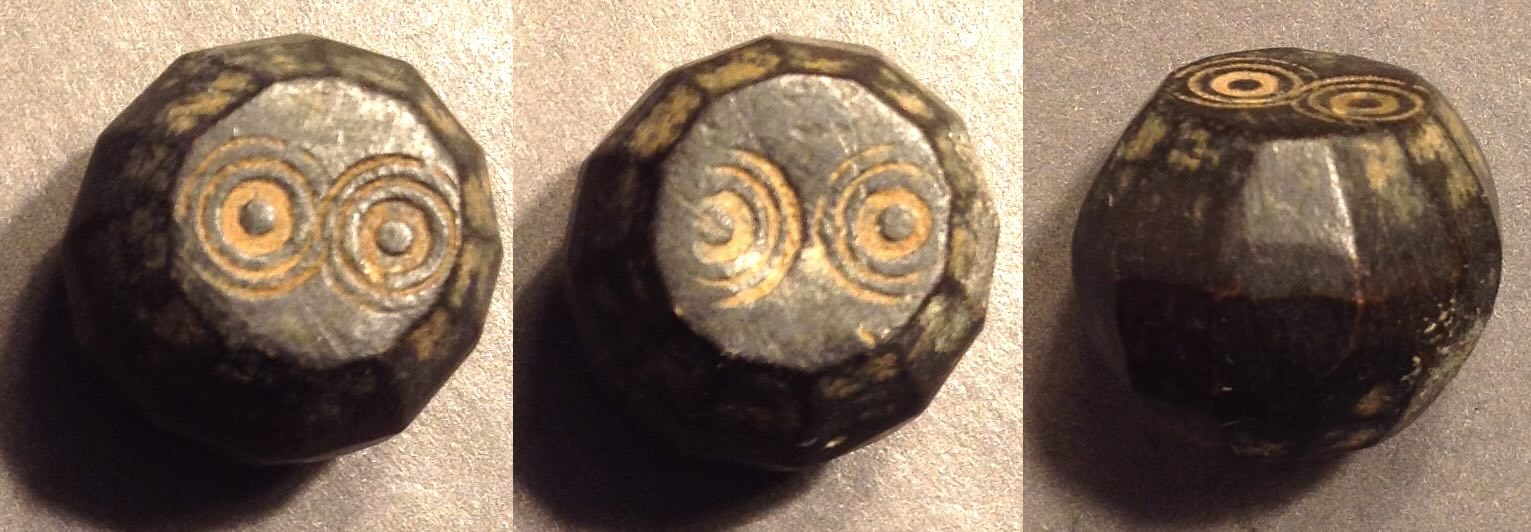 #52513
#52513
10-dirham weight of "pealed orange" shape with a regular 12-sided polygon on the top and bottom and a number of sides between them that is hard to count.
29.39 grams (2.94 grams/dirham). 18.8 mm wide by 15.1 mm high.
Two bird's eyes possibly indicate two times the usual 5-dirham weight.
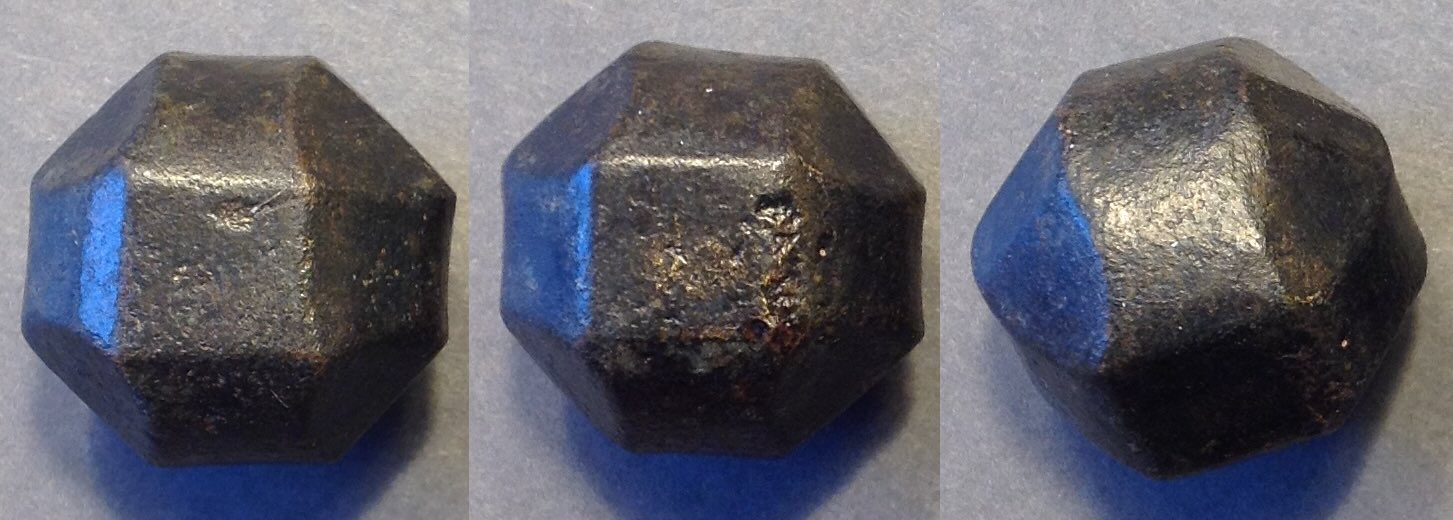 #884
#884
10-dirham weight.
29.20 grams. (2.92 grams/dirham)
17.0 mm by 19.6 mm.
Eight squares around, slightly rounded, with rounded triangles connecting them. No bird's eyes or other marks.
Some Islamic weights are polygonal, but with different shapes than the more-common examples above.
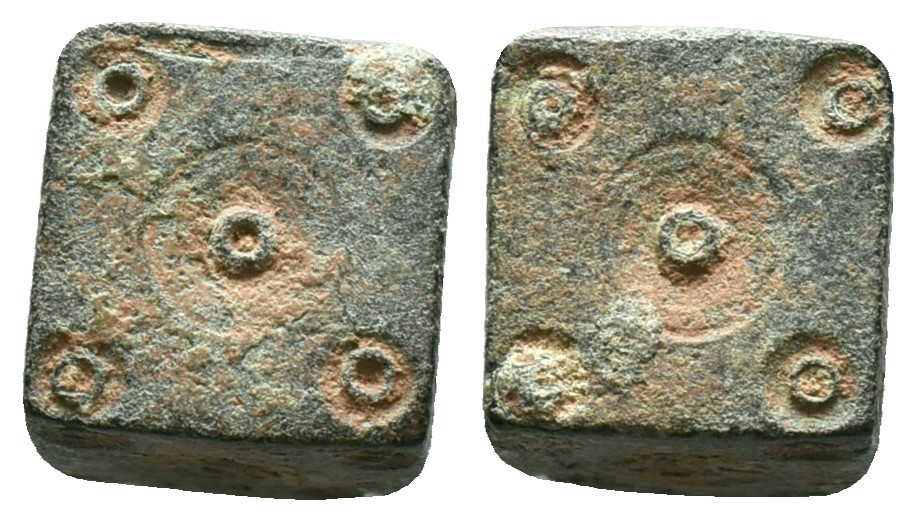 #52527
#52527
5-dirham weight. Cube.
14.29 grams. (2.86 grams/dirham, a bit lighter than most.)
12 mm in each dimension.
Does the different shape mean it is from different region or time-period which was using a slightly lower weight standard?
One bird's eye in the center and four smaller bird's eyes in the corners of each of the six sides.
 #524122
#524122
5-dirham weight with 14 sides--six square and eight triangular--
in the shape of a truncated cube with all eight corners lopped off so that each forms an equilateral triangle.
14.66 grams (2.932 grams/dirham). 16 mm maximum and 12.6 mm minimum.
On this example each side has a shallow incuse rectangle with something in it. Maybe they have letters as designs. They are all similar to each other but do not all seem to be the same and none are clear to me.
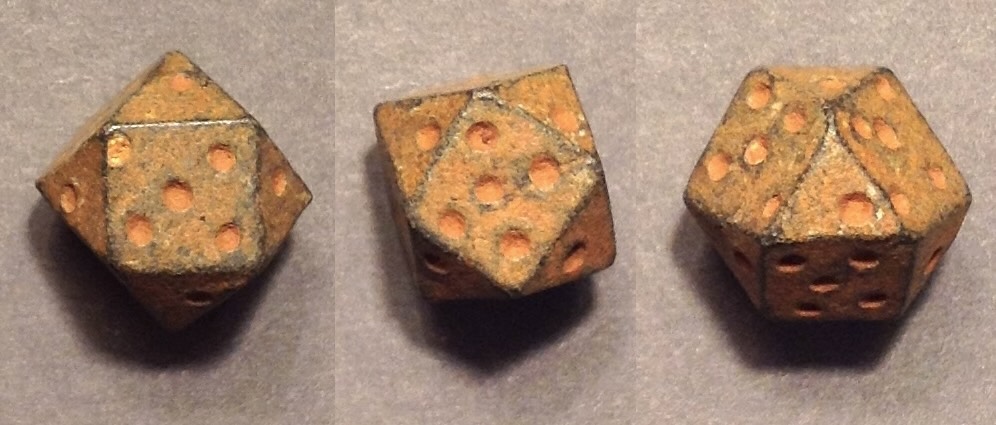 #62458
#62458
2-dirham weight with 12 sides. Six squares and eight triangles.
5.90 grams (2.95 grams/dirham). 12.0 maximum and 9.6 mm minimum.
This is the same basic "truncated cube" shape as the previous 5-dirham piece, but smaller and with different marks in the sides.
I don't know why the square sides have five dots. Maybe that is just the number that would fit?
Islamic polygonal coin weights are common. Holland (1986) published a list of over 600 weights which were surface finds from the neighborhood of Caesarea Maritima (in Israel, on the coast north of Tel Aviv), most of which were lighter brick-shaped weights and 83 were polyhedral. That's just surface finds from one medium-sized city! Apparently, every medieval city in the region, which included Egypt, has weights in abundance. Until the last few decades locals just threw them away as having no value. Now some auction firms are selling them, but prices are very low. Holland wrote, in WWOCM, Chapter 8:
"Of all the different sorts of weights to be found at Caesarea Maritima, the Islamic bronze are by far the most numerous. I have examined more than two thousand, the great majority of them unmarked. The inscriptions on some of the weights (many more await decipherment) link them to the Fatimid rulers of Egypt. This would date them (roughly) to the XI – XIII centuries C.E.
"All of the weights fall (according to mass) into one or other of two series. One series is based on a unit of about 2.9 g. The unit of the other series is about 4.2 g. The two series of weights are therefore often referred to as the "dirham series" and "dinar series" respectively, even though during the period mentioned above (XI –XIII cent. C.E.), these mass-standards were no longer strictly applied to Islamic coinage. It is generally supposed that these weights were used for weighing precious metals --- bullion and/or coin. This supposition is based entirely on circumstantial evidence."
"Flinders Petrie, whose weights were acquired largely in Egypt, does not mention these small weights at all (His own remark, regarding weights in general, is that the fellahin who supplied him considered them worthless, and threw them away, until they were offered a reward --- after which he acquired more than five thousand specimens.)" [Note: This is about all weights, not just polygonal weights. Petrie's comments are from long ago--near the 1920s.]
Examples of other designs. The brick shape and the polygonal design with bird's eyes on all sides are by far the most common. Next are some other designs.
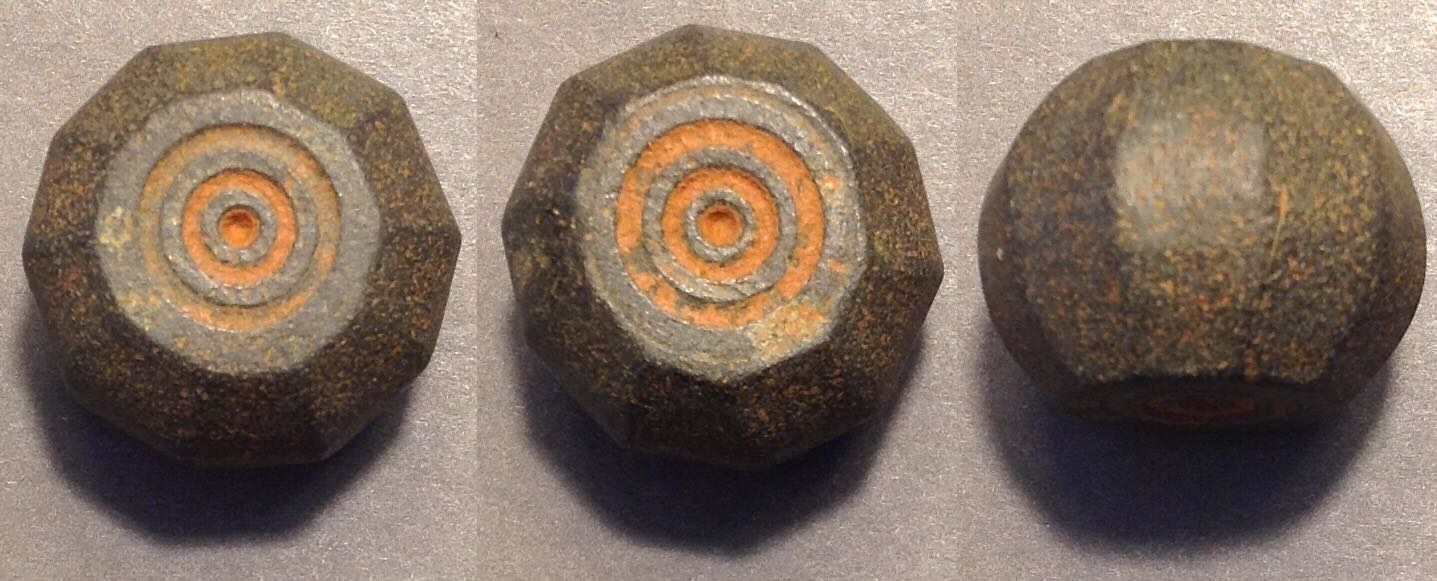 10-dirham weight with two octagons and 24 smaller nearly-square sides in eight vertical rows of three sides each. Each side is rounded making this weight almost a truncated sphere--a spheroid or "peeled orange."
10-dirham weight with two octagons and 24 smaller nearly-square sides in eight vertical rows of three sides each. Each side is rounded making this weight almost a truncated sphere--a spheroid or "peeled orange."
"Bird's eye" pattern only in the octagons.
29.22 grams (2.92 grams/dirham). 13 mm between the octagons. 19 mm maximum.
Holland notes that all the "peeled orange" examples he has seen have octagons.
Some polyhedral weights have fewer "bird's eyes."
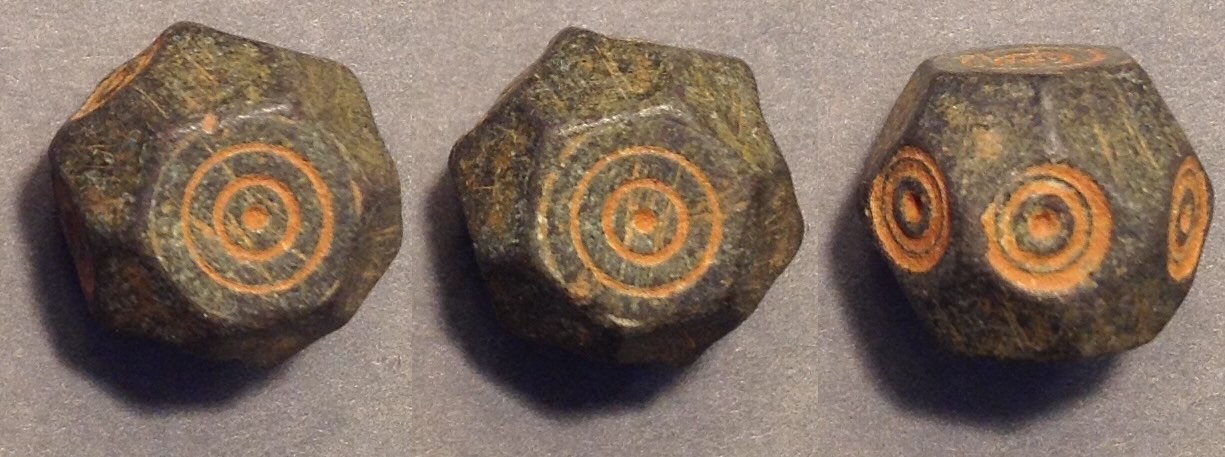 5-dirham weight with two hexagons and 18 smaller sides in six diagonal rows of three sides: pentagon-square-pentagon.
5-dirham weight with two hexagons and 18 smaller sides in six diagonal rows of three sides: pentagon-square-pentagon.
This design is different for having bird's eyes in only one row.
14.49 grams (2.90 grams/dirham). 12 mm between the hexagons. 15 mm maximum.
Most 5-dirham weights have two hexagons and six rows of three smaller sides, but some are different:
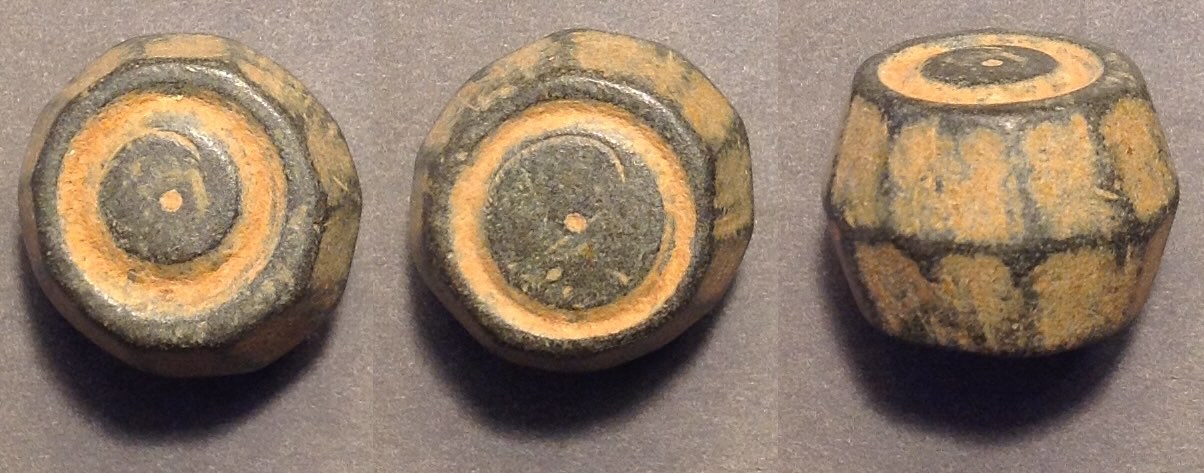 5-dirham weight with two decagons (10 sides) and 20 smaller quadrilateral sides in ten vertical rows.
5-dirham weight with two decagons (10 sides) and 20 smaller quadrilateral sides in ten vertical rows.
14.96 grams (2.99 grams/dirham). 12 mm between the decagons. 15 mm maximum.
This one is almost barrel shaped, but has flat sides rather than rounded sides.
I don't know (and I don't think anyone else does either) if these different shapes are from a different time-period or region, or have any special meaning at all.
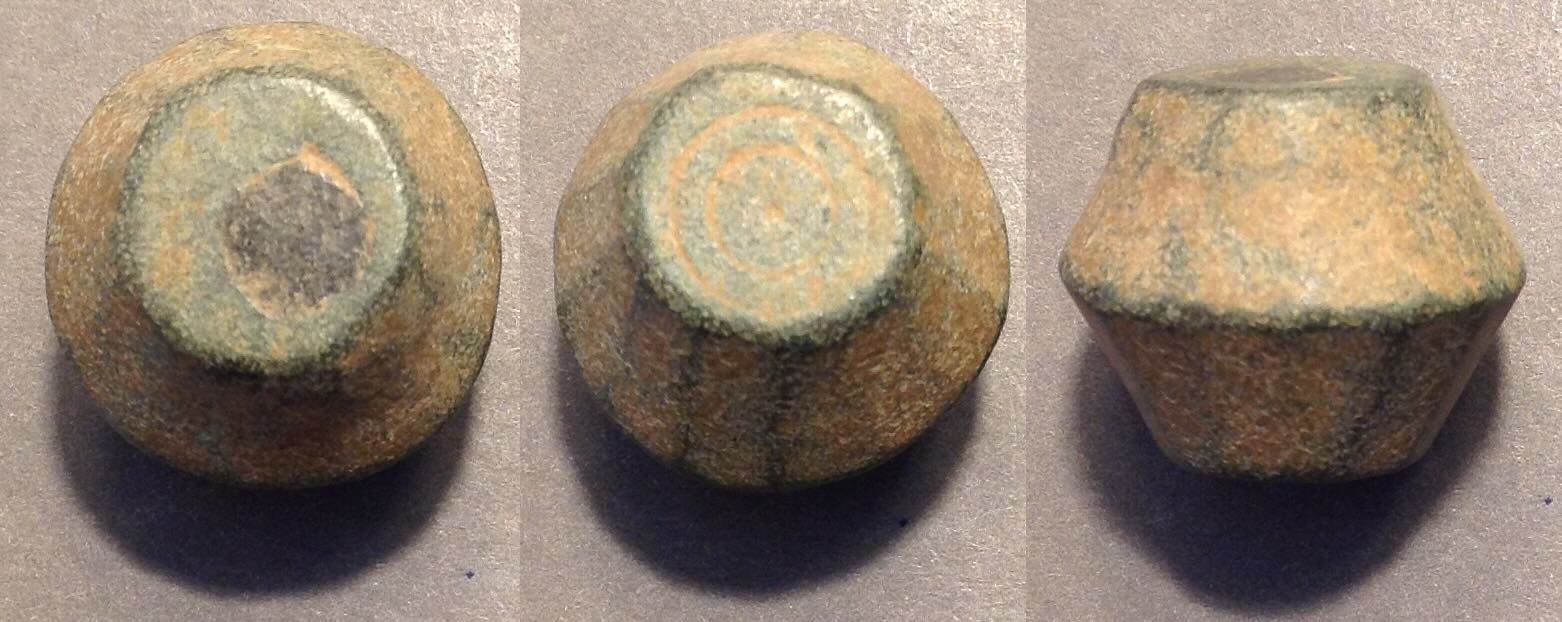 10-dirham weight with two octagons and 16 smaller sides in eight vertical rows, each with two four-sided sides.
10-dirham weight with two octagons and 16 smaller sides in eight vertical rows, each with two four-sided sides.
Only one (very weak) "bird's eye" pattern in one of the octagons.
29.82 grams (2.98 grams/dirham). 16.8 mm between the octagons. 20 mm maximum.
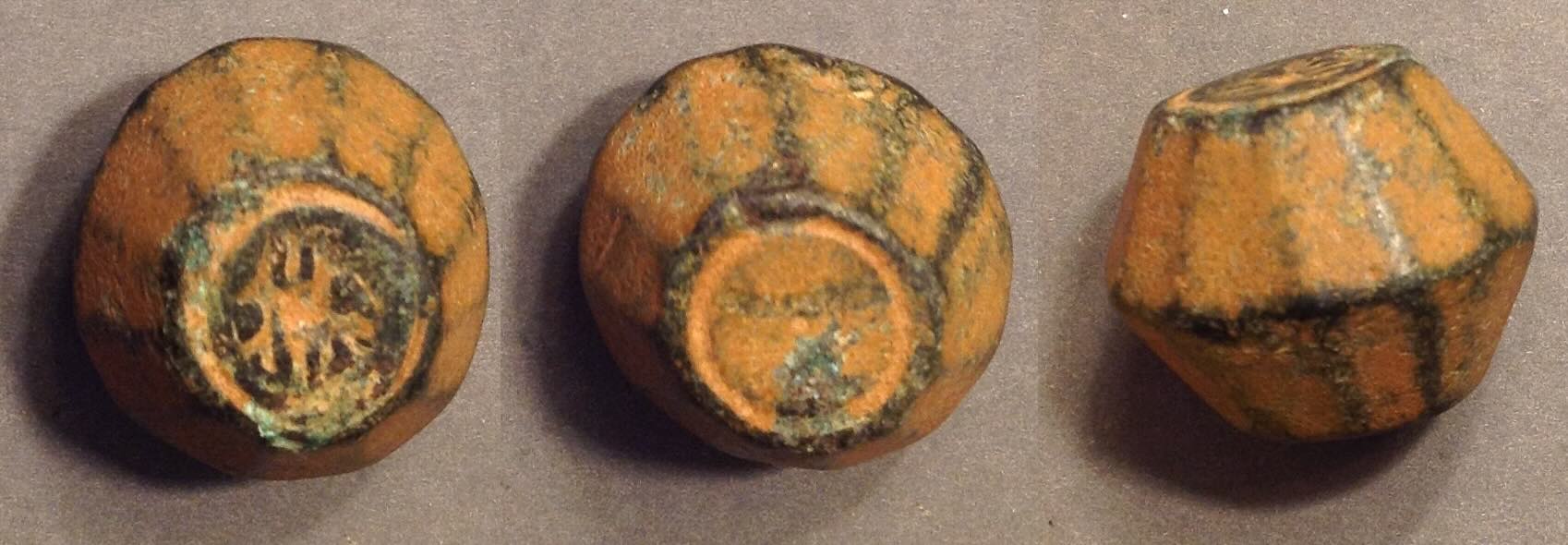 This one is similar, but has a legend on one of the octagons. The legend seems to be "la ilah illa"
This one is similar, but has a legend on one of the octagons. The legend seems to be "la ilah illa"
"There is no God except Allah".
10-dirham weight with two rounded octagons and 16 smaller sides in eight vertical rows, each with two four-sided sides.
29.59 grams (2.96 grams/dirham). 16.6 mm between the octagons. 20.6 mm maximum.
Dinar-standard weights. Most Islamic weights are denominated in dirhams (the dirham was a silver coin denomination), but some weights are denominated in dinars (the gold coin denomination). The dinar is a coin denomination and its theoretical mass is called a mithqal [Schultz, 2003]. Weights can be used to make sure that coins offered in payment actually have the theoretical mass they should have.
The gold dinar originally weighed c. 4.55 grams [needs confirmation], close to the weight of a Byzantine solidus, but the reform of Abd al-Malik in 693 changed it to c. 4.25-4.19 grams, close to where is stayed for centuries although it seems to have been slightly less (c. 4.16 grams [my observation]) in the Fatimid period. However, unlike Byzantine solidi, Arabic gold coins have widely varying weights and must have been weighed individually for each transaction. Weights on the dinar standard are squat and circular, a shape called "discoid." Dinar barrel weights are like thick disks, proportionally wider and shorter than the dirham barrel weights.
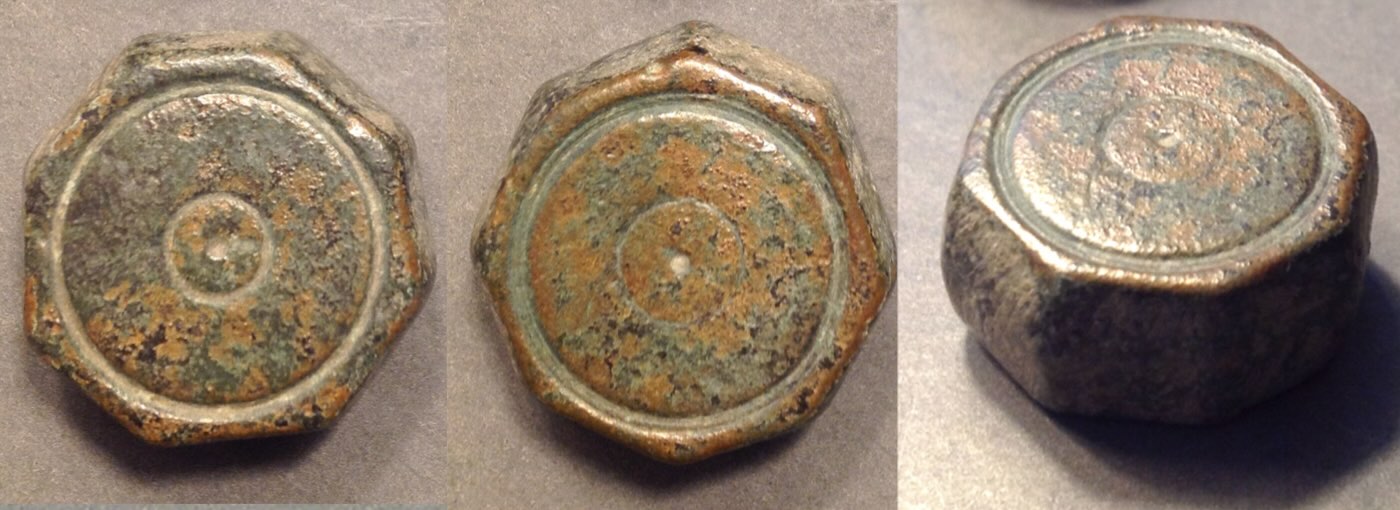 #1040
#1040
An Islamic 10-dinar (not dirham) weight. 10 mithqals.
22.8 mm side to side and 12 mm thick. 41.41 grams.
(4.14 grams per dinar).
This dinar-standard weight is octagonal and close to "discoid," unlike dirham weights. Slightly convex vertical side segments.
Balog (1970) shows three octagonal weights with legends that he attributes to various Fatimid rulers from 1101 to 1160 AD.
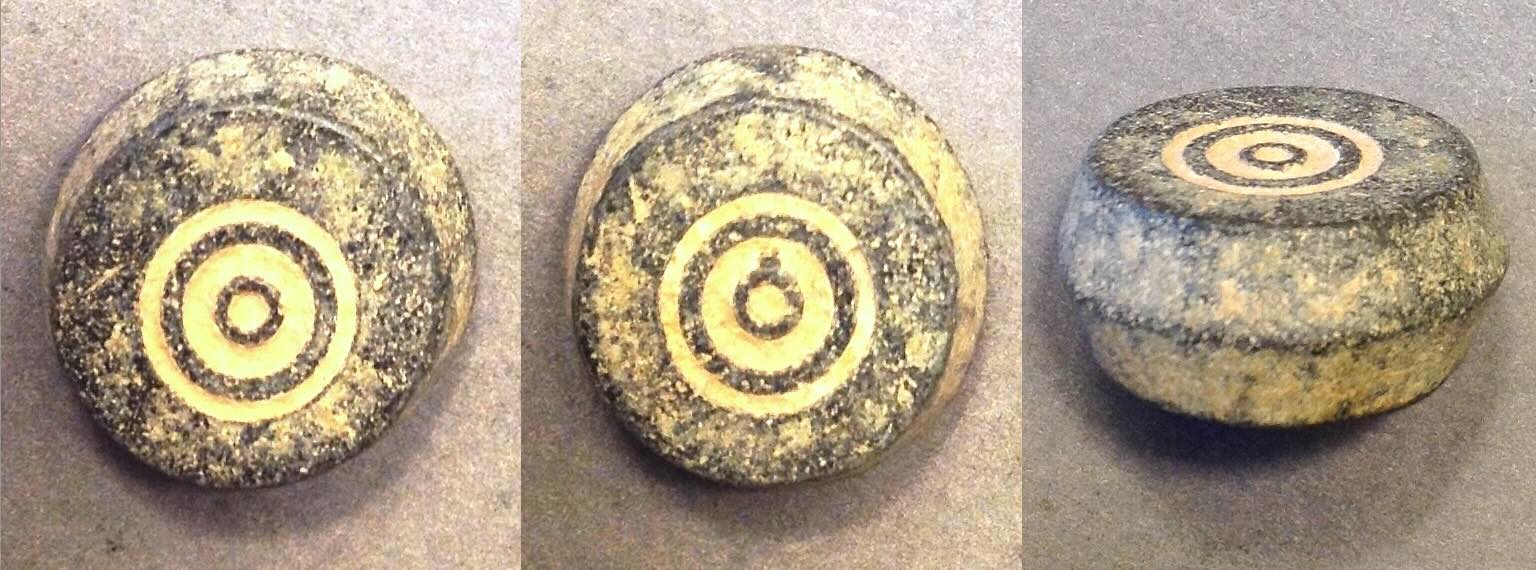 #24137
#24137
An Islamic 5-dinar (not dirham) weight.
19 mm in diameter and 9 mm high. 20.81 grams.
(4.162 grams per dinar).
This dinar-standard weight is "discoid," unlike dirham weights.
#24221
A discoid weight on the dinar standard. This one is 2 dinars.
14.2-13.8 mm diameter and 6.9 mm thick. 8.28 grams (4.14 grams/dinar).
It has two bird's eyes for the denomination (even though the larger weight above does not have five bird's eyes.
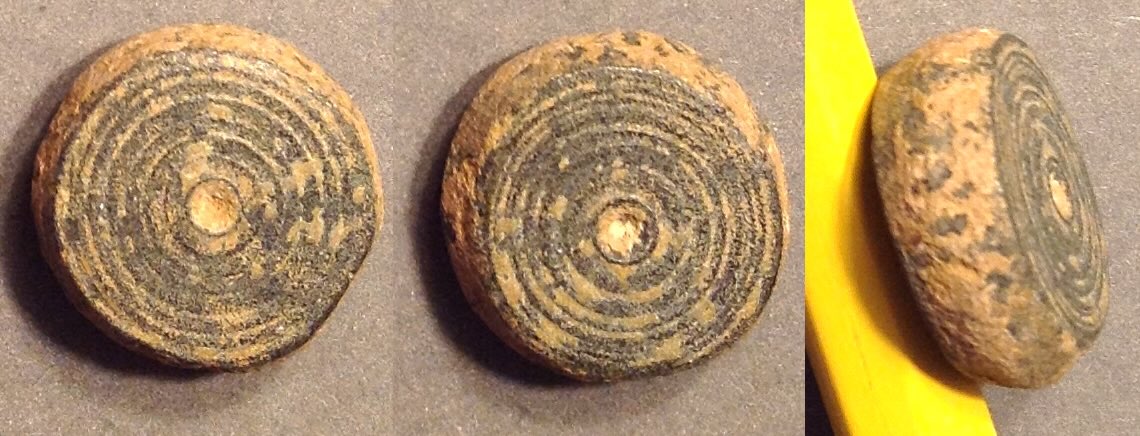 #2514
#2514
A 2-dinar weight.
15.8 mm diameter and 5.6 mm thick. 8.40 grams (4.20 grams/dinar).
It has 7 or 8 circles around a central depression. Nothing of the design suggests the "2" in 2 dinars.
(The yellow is part of a pencil used to prop it up.)
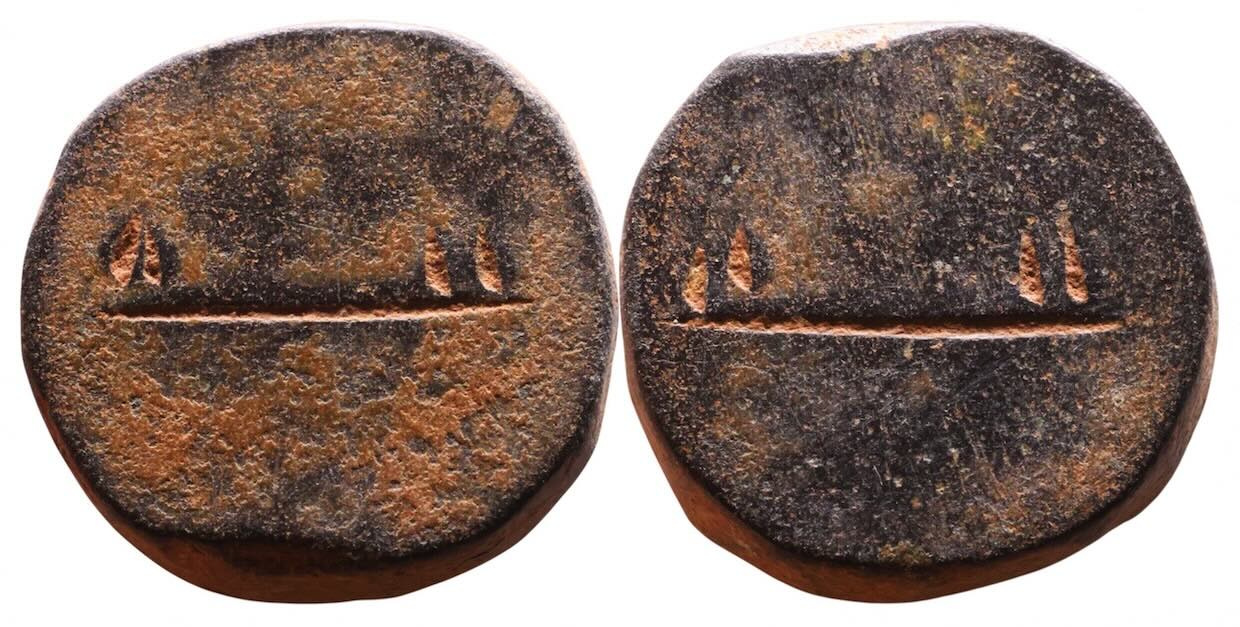
#1085
A 2-dinar weight.
8.28 grams. (4.14 grams/dinar)
15.3 by 4.9 mm.
On each side a line with two vertical strokes at each end.
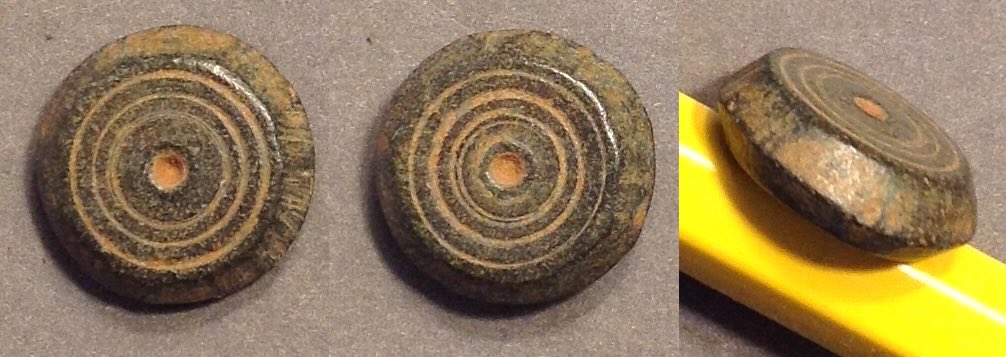 #24165
#24165
Another discoid weight on the dinar standard. This one is 1-dinar with one bird's eye.
13.1 mm diameter and 4.4 mm thick. 4.06 grams.
 #606
#606
8.24 grams. 13.7 mm diameter and 7.8 mm thick. A squat barrel.
A 2-dinar weight. (4.12 grams/dinar)
This one is unusual for having lettering. If you can make out what is says, let me know: 
.
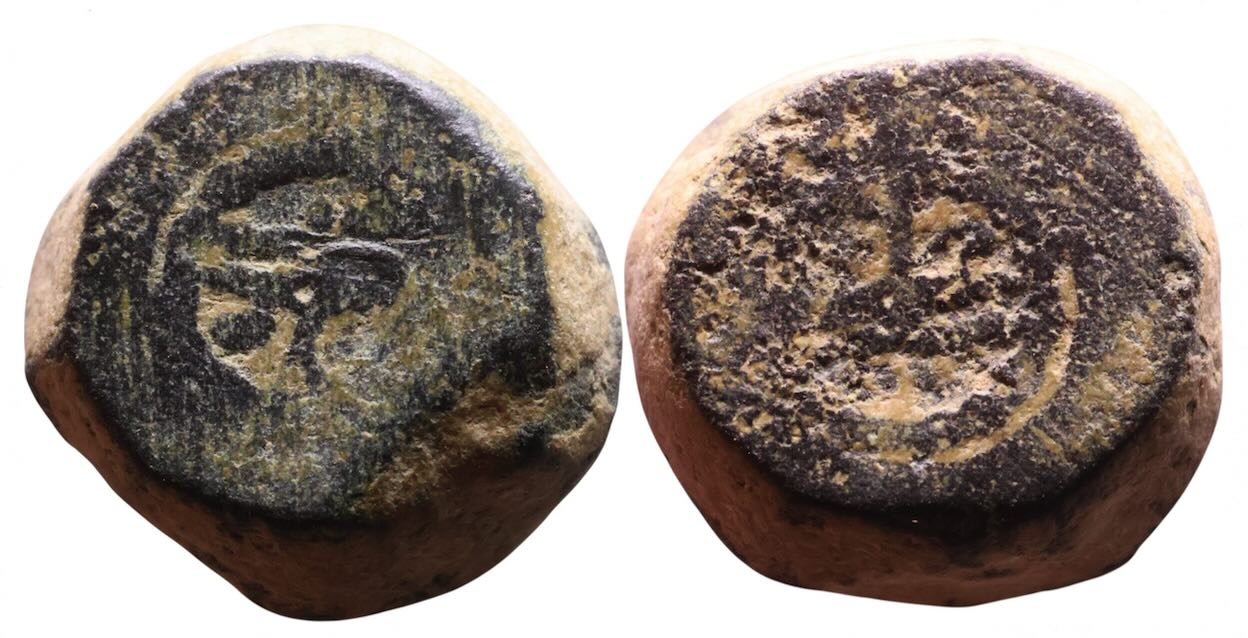 #1102
#1102
A one-dinar weight. A squat barrel.
4.13 grams.
11 mm diameter. 5.8 mm thick. Much thicker than most weights of this small diameter.
Legend not yet translated.
If a dinar-standard weight has a legend which names the weight standard, it says "mithqal," which is the theoretical weight of a "dinar". Think of a dinar as a coin denomination and a mithqal as its theoretical weight. Coins do not necessarily weigh what they are supposed to (and neither do weights).
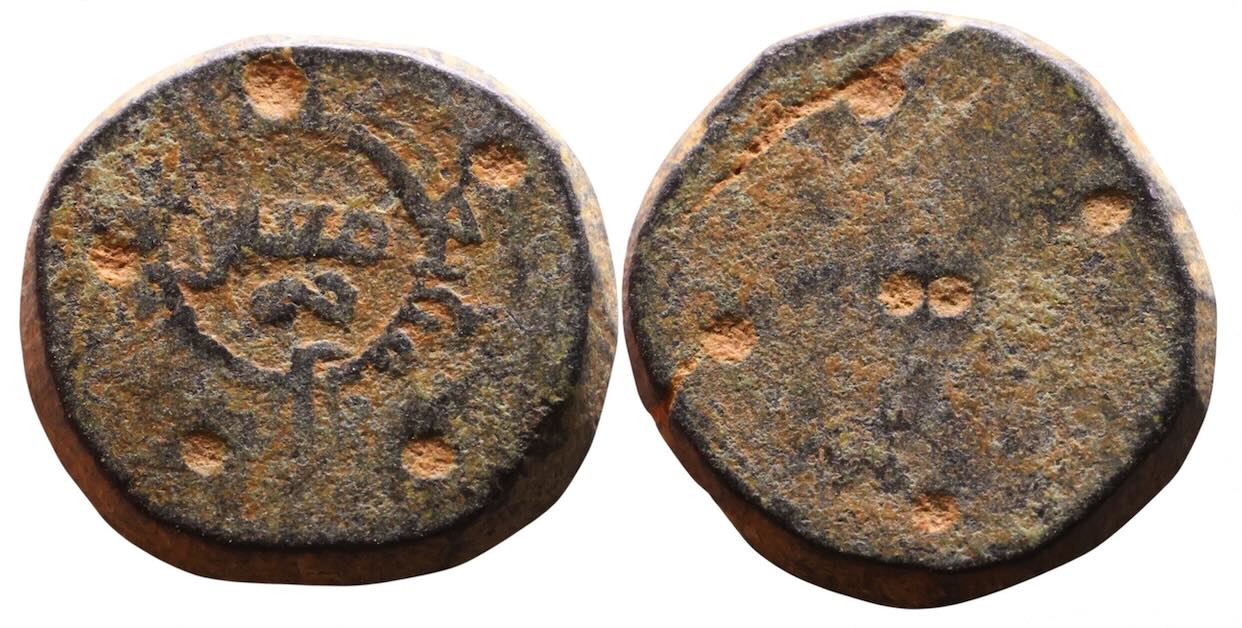 #1096
#1096
A one-dinar weight. Rare for having six punch marks on the reverse. 6/6 = 1.
4.14 grams.
14.4 diameter. 3.2 mm thick.
It looks like it has five punch marks on the obverse. There may be another one, encrusted and hardly visible, at 4:00.
The obverse has a circular legend enclosing a short two-line legend.
Ref: AR1. In center, معير واف (ma'ir waf) which means “complete standard” or better translated as “full standard”.
Small polyhedra. Next is half-dinar weight which is unusual for being a small polyhedron. Weights with light masses are very common, but usually have flat shapes rather than polyhedral shapes. (Flat weights are discussed on another page.)
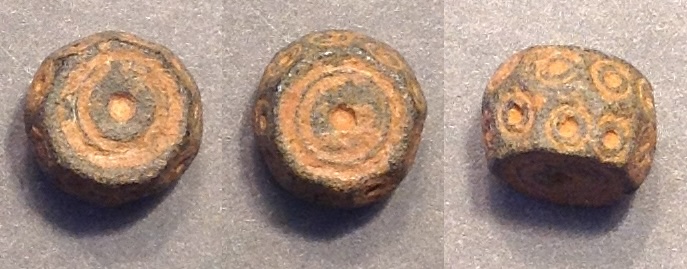 #24122
#24122
Very small polygonal weight with 18 sides--two octagons and two horizontal rows of eight pentagons.
8.3-5.3 mm. 2.05 grams. The sides are much smaller than on the 5-dirham examples.
It is much too light to be a 1-dirham weight (c. 2.94 grams) and it has the squat disc-shape of the dinar series. Its mass is very close to a half-dinar. (Half of 4.2 grams is 2.1 grams.) I think it is a half-dinar weight (4.10 grams/dinar).
For much more on dinar-standard weights, see here.
 #1368
#1368
1.475 grams. Half dirham. (2.95 grams/dirham)
Truncated cube. (A cube with each corner cut off to form an equilateral triangle, forming a shape bounded by six squares and eight trangles.)
5.8 to 5.7 mm between the squares. Tiny!
Bird's eyes in each square.
Polyhedral shapes this small are very rarely seen. Perhaps very few were made and their current rarity reflects that properly. Or, it may be that more were made than we are seeing but their small size makes them hard to find. Or it may be that the market for them has not been identified and finders and sellers are not offering them. My opinion is that low-denomination flat weights were accepted and much easier to make, so there was little reason to spend the extra effort to make small weights using complicated polyhedral shapes. Maybe for higher denominations the difficulty of counterfeiting polyhedral shapes made it worthwhile to spend the effort to make them.
Which standard? Weights that do not conform to these standards might simply be poorly or criminally made, or worn and corroded, but they might simply be from a different culture or region, especially if they lack the bird's eyes.
Bendall notes [p. 7] "We know from a law of Honorius (393-423 C.E.) preserved in the Codex Theodosianus that certain tax-receivers had weights heavier than they should have been and from the Book of the Prefect that certain grocers in Constantinople had weights that were lighter than they should have been. Both would have yielded their owners an illegal profit."
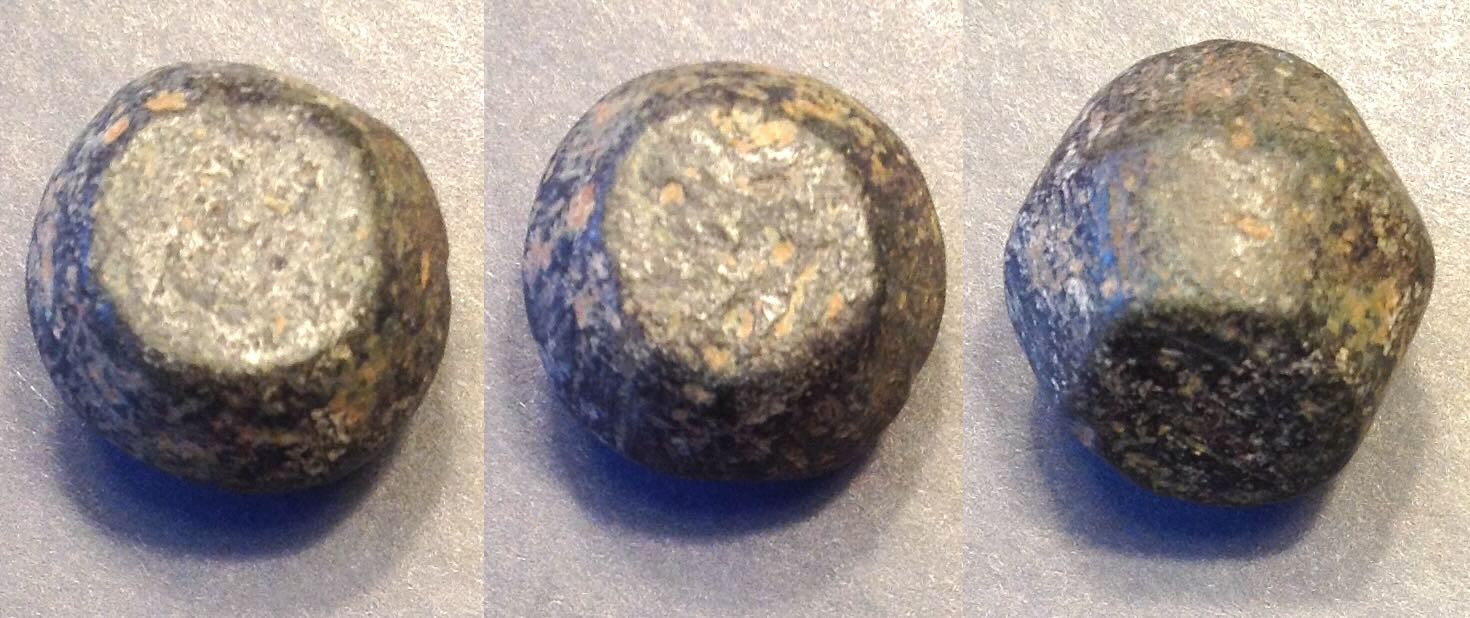 A barrel weight.
A barrel weight.
18.6 mm wide. 16.2 mm tall. 27.88 grams.
27.88 grams is not far from a 10-dirham weight which should be 29.4 grams, but the close conformance of polyhedral weights to the dinar standard suggests this weight is not from the same series as the polyhedral weights above. Also, the two flat sides are not parallel, which might indicate it is not official.
Maybe it is Roman or Byzantine. Could it be a one-ounce weight using the Roman pound? The weight of the Roman pound is subject to scholarly dispute, but is probably near 327 grams under the Republic and lighter later. The corresponding ounce would be 27.25 grams of less. So, maybe this weight at 27.88 grams is slightly overweight or maybe it isn't a Roman one-ounce weight.
I am accepting suggestions, information, and supporting evidence. Write me at  .
.
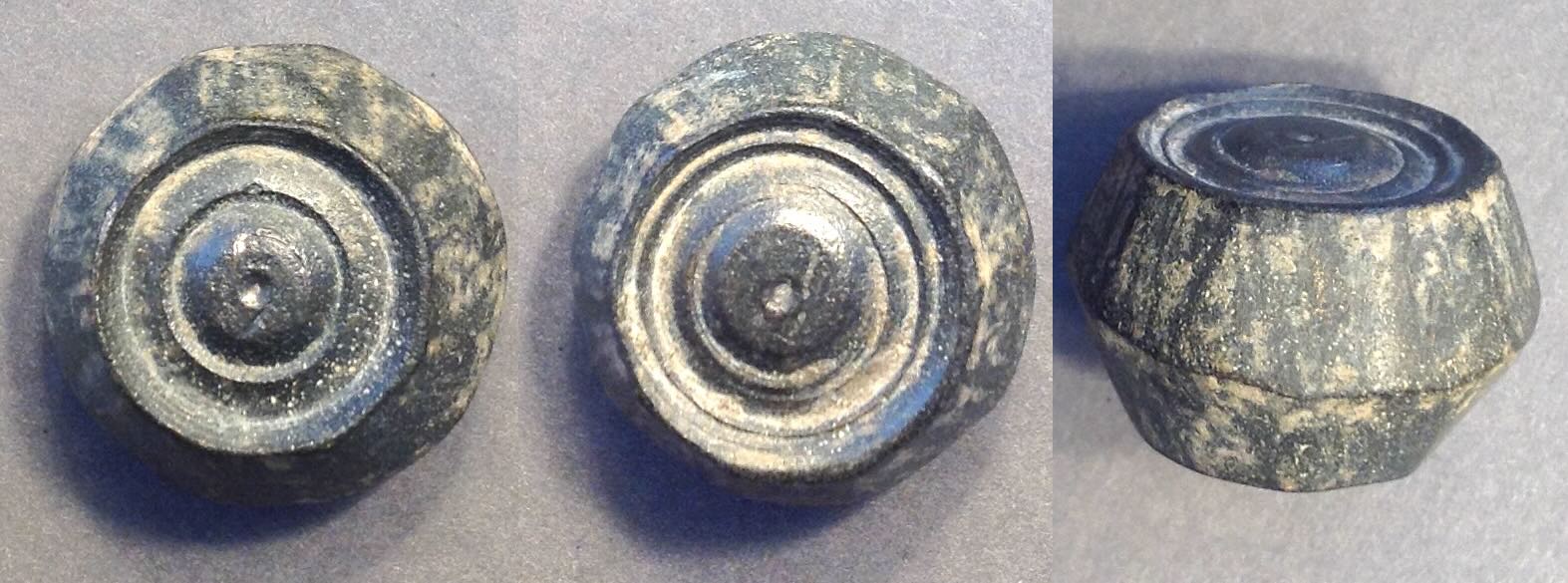 Uncertain denomination. Uncertain culture. Uncertain era.
Uncertain denomination. Uncertain culture. Uncertain era.
This shape is hard to describe. Maybe "Two truncated cones back to back."
30.22 grams.
21 mm wide and 13.4 mm between the flat sides.
It is close to round making the sides hard to count. The middle image suggests 11 sides (unlikely) and the left image is too rounded to count.
The 10-dirham denomination tends to be close to 29.4 grams plus or minus a few tenths. At 30.22 grams this weight is outside the usual range.
For more examples (but not more discussion) see the second page.
Unanswered questions. Many questions that leap to mind do not have published answers. Here are a few.
The weights with bird's eyes are thought to be Fatimid. Is there any way to date them more precisely?
What were they used for and how?
Why don't we find more balances and parts of balances to go with them?
Why are weights so numerous under the Fatimids but apparently not so numerous earlier or later?
How were the polyhedrons made? Cast? Filed down into shape? Were the bird's eyes inscribed or punched (how?) after the general shape was made?
Are the weights without bird's eyes from the same culture? Same time period?
Do different shapes/designs come from different regions/cities?
Many barrels and "pealed orange" weights are on the same weight standard as these polyhedra. Are their designs different intentionally? Why don't they have more distinctive markings?
Coins indicate the issuing authority and their design serves as a state guarantee. Does the design of a weight indicate something similar?
Here is a page about problematic weights which pose unanswered questions.
By the way, if source countries had laws like England's "Treasure Trove" law and "Portable Antiquities Scheme" some of the above questions could be answered. If finders could report where they were found while retaining some financial incentive, scholars would have access to far more information about these types of weights.
A24156
Conclusion. Islamic polyhedral weights, probably from the Fatimid era (10th-13th C.), are common from Syria, Lebanon, Jordan, Israel, and Egypt. Unfortunately, there are few scholarly sources about them. Most are 5- and 10-dirham weights, but heavier and lighter polyhedral denominations were also used. Their masses are notably regular and correspond to a dirham of c. 2.94 grams. Small fractional denominations are flat--not polyhedral.
There are also Islamic weights on the dinar system which used a dinar of c. 4.16 grams. Dinar-standard weights are rarely polyhedral. Most are round and flat, a shape called "discoid".
There is no published contemporary documentation of the uses of Islamic weights. They may have been used to weigh silver for transactions, but evidence for that is lacking other than the fact that the masses fit. However, glass weights from Egypt sometimes have legends that mention specific rare and valuable botanicals (e.g. medicines, spices, aromatics for sacrifices) that have high value in small amounts and it seems likely these Fatimid weights may have had those uses too [reference desired].
References: Go to a page of references on Islamic weights.
For more examples (but not more discussion) see the second page.
Go to a page on Islamic flat weights for lower denomiantions.
Go to a page on problems with attributing weights.
Go to a short page on Byzantine weights. A
Go to the main Table of Contents page for this entire group of educational pages about ancient coins.
 Islamic Polyhedral Weights
Islamic Polyhedral Weights  A 5-dirham weight with two hexagons and 18 smaller sides in three horizontal rows of six sides (or, you could think of it as having six diagonal rows of three sides).
A 5-dirham weight with two hexagons and 18 smaller sides in three horizontal rows of six sides (or, you could think of it as having six diagonal rows of three sides).











 A follis (nummus, 27 mm. 10.04 grams) of Roman emperor Diocletian (284-305 AD) with the reverse illustrating the personified Moneta holding a balance. She holds it between the thumb and index figure with the other fingers held up to show they are not tipping the balance. The coin's reverse legend is
A follis (nummus, 27 mm. 10.04 grams) of Roman emperor Diocletian (284-305 AD) with the reverse illustrating the personified Moneta holding a balance. She holds it between the thumb and index figure with the other fingers held up to show they are not tipping the balance. The coin's reverse legend is




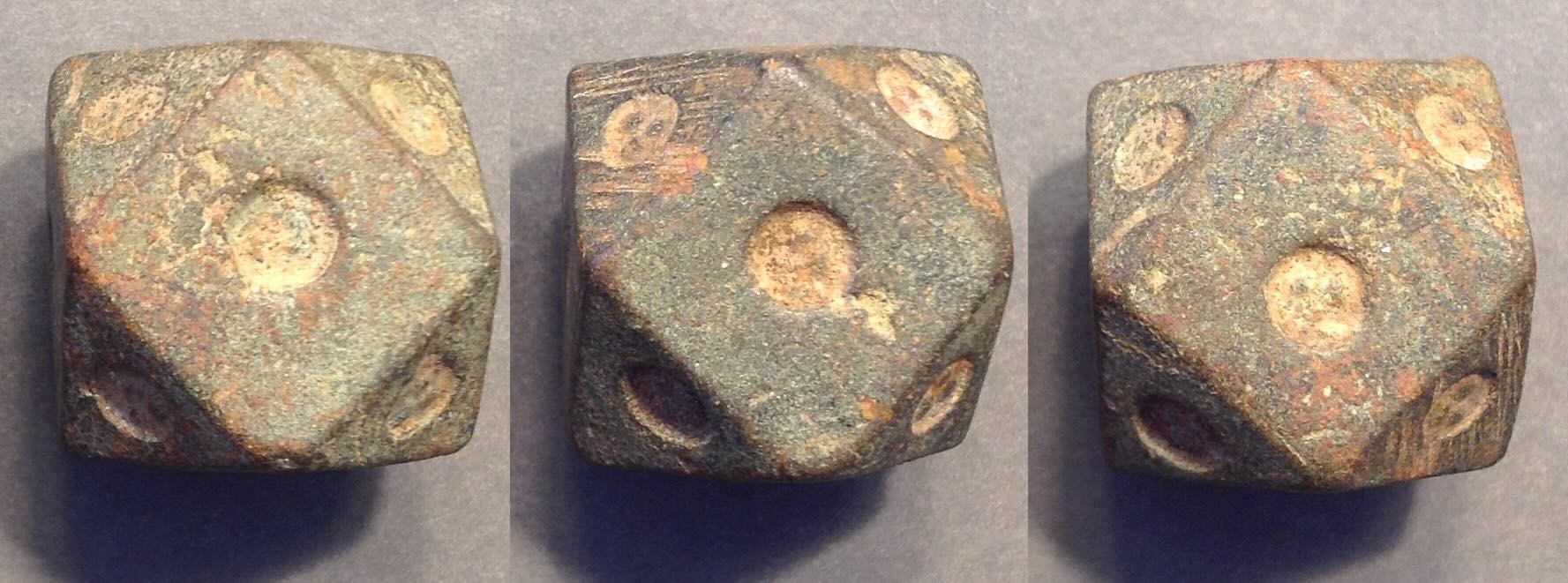
 #524219
#524219
 #877
#877
 #52513
#52513 #884
#884 #52527
#52527








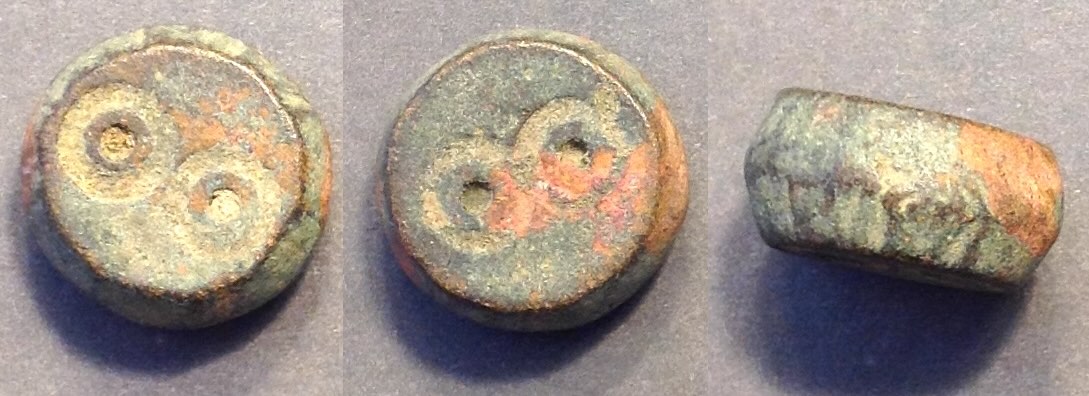




 .
.




